

Breaker Trips When I Turn The Light On – How To Troubleshoot
Breaker trips from light switch. I turn the kitchen ceiling light switch ON and the circuit breaker trips . I am assuming the light switch or the light fixture is the cause. What can cause the breaker to trip when the light switch is turned on?
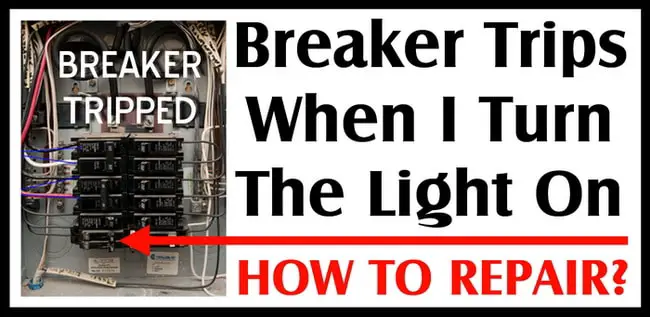
There are different reasons why a breaker will trip/reset when you turn on a light using a wall switch. See below for the reasons why flipping on a light switch could cause a breaker to trip/flip/reset.
SAFETY: Be sure to flip the breaker off when inspecting or troubleshooting any electrical issue. Use a flashlight or headlamp to safely inspect the area. Use the appropriate tools/gloves when working with electrical components. It is recommended to read this complete page before you begin troubleshooting your electrical issue.
Quick Troubleshooting: Start by turning the breaker OFF. Check the light switch by removing the switch cover. Fix any wires that are loose or damaged. Check the light fixture for any brittle/damaged or loose wires. If both the light switch and light fixture are wired properly, next inspect the wiring within the circuit. Most “breaker tripping” issues in this case involve the light switch and or the light fixture. For more detailed information keep reading below…
Recently replaced the light switch or fixture? If you have replaced the light switch or light fixture with a new one and the breaker trips when you turn the light on, the switch or fixture is most likely wired incorrectly. Turn off the circuit breaker and rewire the switch or fixture. Use the wiring diagram that came with the light switch/fixture to wire it correctly.
Having electrical issues with your ceiling fan? Ceiling fans may vibrate connections loose and cause a tripping breaker.
What do I check to fix the breaker from tripping? To find out why the breaker trips when you turn the light on, check the wiring, the light fixture, and the light switch. Inspect all components to be sure the wiring on the light fixture and light switch are not loose or damaged. Check the switch and fixture for the correct wiring with no shorts to neutral/ground. All of these conditions can cause the breaker to trip.
How To Fix Light Switch/Trips Breaker
Troubleshoot efficiently by checking the switch first. Remove the switch plate (2 screws) and check the switch with a flashlight. Inspect for any wiring touching the side of the box or other wires. Fix as needed, then check the light fixture and inspect the wiring for issues. If the issue goes beyond the light switch and light fixture, call an electrician to troubleshoot the problem.
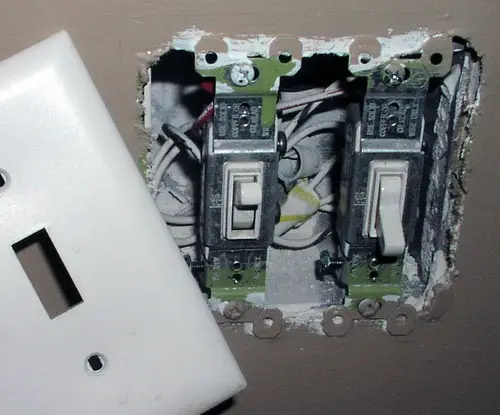
When a light switch trips the breaker, a faulty light switch or light fixture is usually the cause. A wire may have come loose at the switch or fixture and is shorting out the hot wire. Always check the switch and fixture first.
Also check any GFCI receptacles that are on the circuit for a malfunction or fault.
If you recently hung a picture or put a nail/screw through the wall, this is likely your issue as a nail or drill bit may have damaged the wiring. If a nail or screw has damaged the wire, you can replace the wiring around the fault by using junction boxes for the splice.
Why Does Light Switch Trip Breaker?
See below for the reasons why a breaker can trip and what may be causing the problem. There can be more reasons but these are the most common/average.
Light Switch Can Trip Breaker When:
- Light Fixture Fault
- Light Switch Is Faulty
- Wire Connections Are Loose
- Short Circuit Issues
- Ground Fault Problems
- Nail/Screw Through Wiring
- Rodent Chewed/Damaged Wires
- Faulty GFCI Receptacle
Reasons Light Switch Trips Breaker
1. Light Fixture Fault If a light fixture is faulty, a breaker can become overloaded. The wires in an old light fixture can fall apart and cause a short or ground out. Turn off power before checking the light fixture for damage. Replace the light fixture if found to be faulty.
2. Light Switch Is Faulty A light switch that has become faulty can short out and trip a breaker. An old light switch can crack and become unusable and cause the breaker the flip. The wires can become brittle and cause a circuit overload or a short. Turn off the breaker when checking the light switch. Replace the light switch if found to be faulty.
3. Wire Connections Are Loose If any of the wires become loose it can ground out and short circuit causing the breaker to trip/reset. Remove power, remove cover if applicable, and inspect the terminal screws on the switch to be sure they are not loose. If loose, tighten the screws and be sure they are secure. Be sure terminal screws are tightened all the way down.
4. Short Circuits A wire is contacting another wire and current flows through and flips the breaker. Wires can become brittle and the insulation can fall off. Inspect all wires to be sure there are no short circuits. Replace any wiring if you find it to be brittle and or the insulation has become brittle and falling off. This causes grounding and shorts.
5. Ground Faults This happens when a live wire comes in contact with a metal area of the switch housing or similar. This can cause shock and also trip the breaker. Inspect all areas on the wiring to be sure there are no ground faults.
6. Nail/Screw Through Wiring If you have drilled into the wall to hang a picture lately, you may have drilled too deep and damaged a wire. This is a difficult scenario as the damaged wire will need to be repair and or replaced. It is best to call a pro at this point.
7. Rodent Chewed/Damaged Wires A rodent in the wall may have chewed on the wiring. This will cause damaged wiring and cause a short that will flip the breaker. The wiring will need to be repaired or replaced.
8. Faulty GFCI Receptacle Check any GFCI receptacles on the circuit for a malfunction. If the light switch wiring is going through a GFCI receptacle and the GFCI is faulty, this can cause a problem and trip the breaker. Replace the GFCI receptacle if found to be faulty.
More common electrical problems and solutions:
What To Do If Electrical Breaker Tripping In Your Home?
Microwave Oven Tripping Breaker
Power Out In One Room But Rest Of The House Has Electricity?
No Power To Outlets In One Room Or Wall
If you have read through this page and still have a light switch that trips the breaker, please describe your issue below and we will get back to you with a solution.
Please Share The Love

You May Find These Related Articles Helpful...
About the author, keith vetter, leave a reply.
- Default Comments (8)
- Facebook Comments
8 thoughts on “Breaker Trips When I Turn The Light On – How To Troubleshoot”
I just recently moved into a old family rental house and in the kitchen there is a ceiling fan light combo and a block off plate for the switch meaning no switch. Well I got tired of having to pull the cord while walking slowly to try and not trip in the dark. I pulled the cover off the wall and have old 2 wire 1 yellow or white and 1 black both capped off. So I thought easy enough and hooked a switch up to it not thinking. The light and fan have power so putting a switch here will do nothing. Well acted without using common sense and installed a switch, when the switch is off lights and fan working as they were before, when I flip the switch on it throws a breaker and the light and fan turn off. So I took the fixture down and it’s wired White wire to white wire green capped black to black and in the same wire nut black to blue there is 4 different wire strands coming into the ceiling box all 2 wire – black and white all besides 1 set are wired together and then to the fixture. Another reason I’m putting in a switch is because we’re thinking about moving the fan and light to the living room and putting a standard light fixture, we can’t do that if theirs no switch it stays on constantly.
I have 6 spotlights in my kitchen ceiling , when they are turned on after some time the breaker will trip , tried installing new spotlights and it still tripping , any suggestions please
My lightswitch has 3 sets of wires coming into it, live feed from the box, run to the light, and continued circuit through to the outlets. I wired a piggy tail from the live feed to the switch and connected the light run and outlet run together with a piggytail. All whites are capped and all grounds are capped. I have to power to my light switch but no power to my outlets. When I flip the switch it shorts out the AFCI Breaker. I then checked to see if it is the light and so I hard wired the light to the live feed from the breaker panel and the light stays on while the switch is off but I still have no power to my outlets. We ran the wire and it all testes great, only time we started to have issues was when I had to change the Breakers out with AFCI Breakers.
Cornelius, Sounds as if there is an issue with the breaker that you are using for the lights. If the breaker for the lights or outlets is causing the main breaker to reset or trip, then check the light breaker for faults or wiring issues. You may want to have a professional assist you as working in a main breaker box can be a safety issue if you do not have much experience with high voltage. -RR
I have a problem, my main power box trips when I switch the lights breaker on but when the light breaker is off, all of the electrical outlets are working, please what’s cause of the problem?
installed new light circuit, when the switch is in off position and I flip breaker on, the 2 light fixtures are on, hit the switch to on a the breaker trips. Power is getting to the switch, in off postion the circuit works, turn the switch to on and breaker trips. I must have a wire from switch in wrong plsce or wrong on the first light of two in the circuit.
The breaker started tripping when I added a second light on a combination switch and the switch is also powering a second room and all my wiring is done right, I’m assuming is that the breaker is overloaded but I will like a second opinion or confirm my deduction
I hung a new ceiling fan, the old one was just wired into the neural side of the wiring, all hooked up on the white wire. I rewired the new one into the wiring like it should be, black to black, and white to white, now when i turn on the wall switch it trips a breaker.
Leave a Comment
Your email address will not be published. Required fields are marked *
Save my name, email, and website in this browser for the next time I comment.
Copy and paste this code: xajama *
Leave this field empty
This site uses Akismet to reduce spam. Learn how your comment data is processed .
- svg]:stroke-accent-900"> 826K
- svg]:stroke-accent-900"> 622K
- svg]:stroke-accent-900"> 246K
- svg]:stroke-accent-900"> 45K
Why Is My Circuit Breaker Tripping? 4 Potential Problems and Solutions
By Glenda Taylor , Bob Vila , Evelyn Auer
Updated on Dec 21, 2023 8:55 PM EST
6 minute read
We may earn revenue from the products available on this page and participate in affiliate programs. Learn More ›
Q: Every few hours—sometimes minutes!—my living room and one side of my kitchen lose electrical power. I’ll check the breaker panel and, sure enough, a circuit breaker has tripped…again. Should I call an electrician, or is there a simple DIY fix I can try first?
A: While it’s frustrating when a circuit breaker keeps tripping, they are important safety mechanisms. Designed to shut off the electrical current when something goes wrong, circuit breakers are one of the best ways of protecting a home from an electrical fire. “When a circuit breaker trips, typically it is because we use too much electricity, which causes it to overload and turn off,” says Christopher Haas, expert electrician and owner of Haas & Sons Electric in Millersville, Maryland. For those who need an electrical panels 101 refresher course or aren’t sure how to reset circuit breakers, each breaker has an on/off switch and controls a separate electrical circuit in the home. When a breaker trips, its switch automatically flips “off,” and it must be manually turned back on to restore electricity to the circuit. For those wondering, “Is it dangerous if a circuit breaker keeps tripping?” the answer is that it can be, depending on the source of the problem. An electrician can ultimately deal with the root issue, but a little sleuthing will reveal whether it’s something that’s easily remedied.
In many cases, the cause of a circuit breaking tripping is an overloaded circuit.
A circuit overloads when more electrical current is being drawn through the wires than they can handle, tripping the circuit breaker. If this happens, there may be a few additional signs:
- Buzzing noises coming from outlets
- Devices charging slowly
- Electrical outlets not working
- Flickering lights
- Scorch marks on outlets and light switches
If a circuit breaker keeps tripping in one room, homeowners can test for circuit overload by turning off all the switches in the affected area and unplugging all appliances and devices. After the breaker is flipped back on, the devices can be turned back on one at a time, with homeowners waiting a few minutes in between to see if the circuit remains on. If the breaker trips before all the appliances are turned on, the experiment can be repeated, this time turning them on in a different order. It may be necessary to do this several times to find out how many appliances can be operated at once before the circuit overloads.
“As a short-term solution, you can unplug unnecessary appliances to prevent tripping circuit breakers. You may still get some trips, but you can limit them by unplugging devices that you don’t need to use,” advises Dan Mock, vice president of operations at Mister Sparky , an electrical company with 90 locations in the U.S. The best long-term solution, however, is to pay an electrician for the cost to rewire the house and add additional circuits. The cost to replace an electrical panel is about $1,274 on average.
Other times, the issue may be caused by a short circuit.
A “short” circuit means that two wires that should not be coming into contact are inadvertently touching, triggering a sudden surge of electricity through the wires. A short can occur in an outlet, a switch, or within an appliance if wires are loose or have been chewed through by mice or pets. Some signs of a short circuit include:
- Popping sounds
- Discolored outlets or switches
- Burning smells
Testing to see if an appliance has a short is similar to testing for an overloaded circuit. When an appliance that has a short in its wiring is turned on, it will immediately trip the circuit. Homeowners can also try plugging it into an outlet in a different room. If the breaker for that room trips, there’s a short in the appliance (if it’s unclear what breaker goes to what room, the breaker can be identified with one of the best circuit breaker finders ). Electrical shorts can be a major fire hazard, so it’s a good idea to call a licensed electrician for this circuit breaker repair. It’s wise to stop using the outlet or appliance until a pro takes care of the problem.
Another potential cause of a circuit breaker tripping is a ground fault.
A ground fault occurs when the electricity running through a home’s wiring diverts from the wiring loop and travels to the ground, usually due to faulty wiring or water infiltration in an outlet or switch box. Water is a conductor, which is why walking through puddles is often listed as something not to do in a power outage in case of downed power lines. Once water makes contact with wires, electricity can jump from the wiring loop and follow the water trail. This creates a surge in electricity leading to a tripped circuit breaker. If a person comes in contact with the electricity that is on its way to the ground, this can result in electrocution. Homeowners may notice a few signs of a ground fault, including:
- Tripped GFCI (ground fault circuit interrupter) outlets;
- A burning smell coming from an outlet; and
- Lights flickering.
Newer electrical breakers have features designed to protect against the danger of ground faults. According to Haas, “Ground fault breakers sense electricity going to earth as opposed to going through the wires of the circuit. You’ll find [these] for bathrooms, kitchens, garages, exteriors, and basements.” GFCI outlets are another safety feature that shut off the electric current within a fraction of a second of sensing a ground fault.
If a ground fault is the problem, the cause of the errant water must be discovered and repaired, and any damaged wiring must also be replaced. It’s also a good idea to install GFCI outlets in rooms where water is commonly used. A GFCI outlet costs $210 on average.
Sometimes a bad or worn-out circuit breaker can be the culprit.
In some cases, the circuit breaker itself may be faulty. Breakers that are old, damaged, or were installed incorrectly may trip frequently for no apparent reason. Alternatively, faulty breakers may not trip when they are supposed to, leaving the home at risk of electrical fire. Some signs of a bad circuit breaker include:
- The circuit breaker getting hot and tripping frequently;
- The circuit breaker won’t reset;
- It has been over 10 years since the breaker was last serviced; and
- The breaker has scorch marks.
An important electrical safety tip to keep in mind is that resetting a breaker over and over again can cause what is called an arc flash, which is a small electrical explosion that can be deadly. If resetting the breaker once does not remedy the issue, it’s a good idea for the homeowner to hire an electrician near them who knows how to replace a circuit breaker safely. Mock warns, “Don’t take any chances with circuit breakers. Instead, call a licensed electrician who knows the safe ways to replace breaker boxes, upgrade circuits, and diagnose potential electrical problems in your home.” Wiring a breaker box is a job to leave to an experienced electrician.
A professional electrician can help determine the specific cause of a frequently tripping circuit breaker.
Most circuit breaker problems—aside from those explained in the sections above—will need to be inspected and addressed by a licensed electrician. According to the Electrical Safety Foundation International (ESFI) , each year “thousands of people in the United States are critically injured and electrocuted as a result of electrical fires, accidents, [or] electrocution in their own homes.” While homeowners may be tempted to save on electrician costs by attempting circuit breaker replacement or repair themselves, electrical work is not suitable for casual DIYers. “Yes, you have to pay, but you can save many hours of head-scratching by hiring an electrician. Electricians will also have all the right tools for diagnosing and repairing the circuit,” Haas adds. “Lastly, they will come with a warranty/guarantee should something arise, and they will typically return at no additional cost.”
Anker’s New Home Battery Tower Is a Sleek, Modular Step Toward Complete Energy Independence Anker’s New Home Battery Tower Is a Sleek, Modular Step Toward Complete Energy Independence
By Chase Brush
The Government Is Paying People to Upgrade Their Home Comfort, Here’s Why The Government Is Paying People to Upgrade Their Home Comfort, Here’s Why
By Tony Carrick

Galvin Power is reader-supported. When you buy via our links, we may earn a commission at no cost to you. Learn more
Why a Circuit Breaker Trips When the Light Switch is Turned Off?
Written by Edwin Jones / Fact checked by Andrew Wright
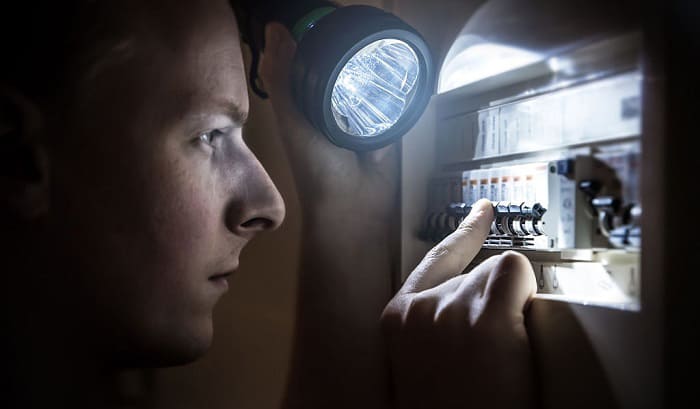
Do you want to use electricity without problems, but your light switch is a headache? If a circuit breaker trips when the light switch is turned off, most likely, it’s a result of a common wiring mistake. However, there are other reasons you should keep an eye on.
You’ll never know what will happen if you let this malfunction go unaddressed, so keep reading and see the listed possible reasons. It is necessary to determine your next step on this matter to maintain a healthy power source for your home.
Table of Contents
You Have a Miswiring in a Switch Loop Setup
A double throw switch is causing the problem, what if your switch is a single pole single throw, a loose wiring connection.
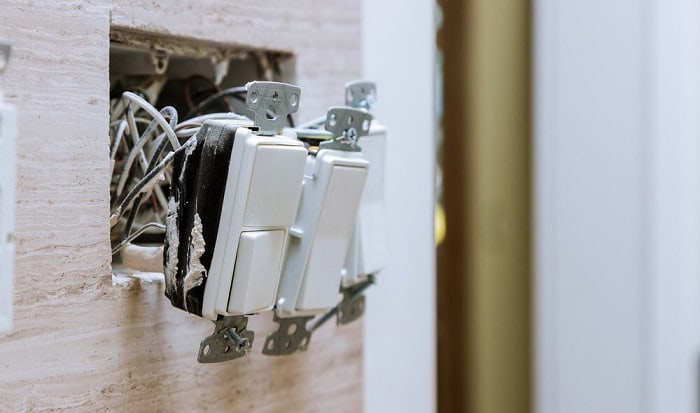
When you install lights, you buy new fixtures, switches, and perhaps a new set of wiring too.
Now you think you did the proper process — hot-to-hot wire and neutral-to-neutral wire, but in the end, the light switch trips breaker when turned off. Even though you reversed the way you plug the wires, the result stayed the same. This pain in the butt frequently happens when you have a switch loop set up.
A typical DIY guy mistake in a switch loop setup is when all black and white wires are connected. This miswiring causes the light to turn on even though the switch is off. Because it’s improper, it shorts the circuit and trips the breaker when the switch’s on.
To properly rewire this connection, you will need a marker and proceed to the following steps:
- First, the circuit breaker’s black wire connects to the white wire and other black wires that feed other devices.
- Remember to put a black marker on both ends of the switch and the light.
- Then, connect the circuit breaker’s white wire to the light’s and other devices’ white cables.
- Next, connect your switch’s black wire to the black wire for the lights.
- Finally, link all the ground wires together and to the ground screw from the lighting fixture and the box.
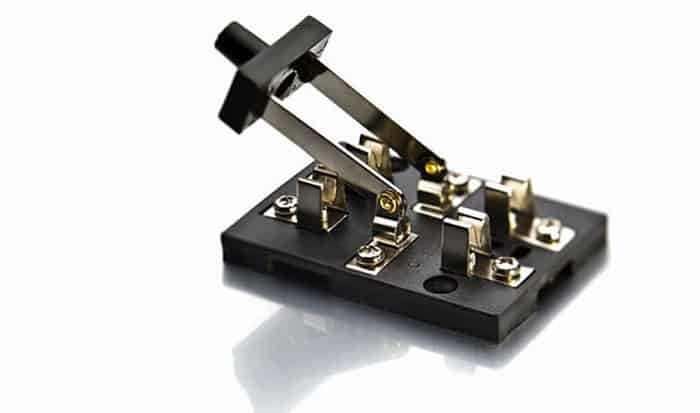
If your residence had a history of a bad renovation or electrical rerouting by an untrained contractor, your wirings might be in trouble. It is time to remove the cover panel of your switch box and investigate the situation of your switch inside the box.
A breaker that trips from an off light switch is not common among households today. This occurrence happens because of poor wiring of a light switch like the “Single-Pole, Double Throw” switch.
You’ll know you have this kind of switch when it doesn’t have ON and OFF markings on the switch toggle.
It’s a bad sign if your switch is leaning on the side of the grounded box where it is mounted. A switch is in an improper position when the switch pole screw lies against the switch box and the runner is shorted, which causes the fuse to blow when you turn the lights off.
Also, the breaker will trip if the runner short circuits to the ground or neutral wire somewhere along the wiring’s terminus.
If you have double-throw switches for a three or four-way switch, look out for a shorted traveler wire. It’s possible a switch was removed, causing the travel wire to short-circuit ( Read now how to test a shortstop circuit breaker here ).
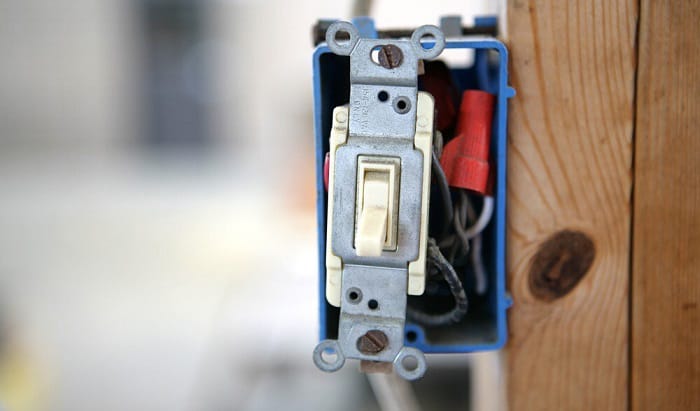
A standard single throw switch is a typical switch for a light fixture. You can typically find this at home with three screws for hot wires and a ground wire. Its clear difference from a double throw is that the switch toggle has an ON and OFF indicator.
Now, what’s the catch when you have a single pole, single throw switch? Will you have the same dilemma as with the double throw? Well, technically, the answer is yes. You can still experience a problem where a breaker trips when switch is turned off, but for other reasons.
If it’s a standard switch, it is easy to blame the button itself when you have a difficulty like this. The controller can be defective due to a manufacturing failure. However, a simple wiring mistake can trigger the breaker to trip just by turning the switch off.
If the ground wire and the hot wires are close enough to each other, toggling the switch can cause a slight movement that contacts them, then BOOM, a ground fault.
There’s also a possibility that the switch is in neutral. Keep an eye on this wiring mistake because you’re turning the power to the neutral and not the hot wire. Reverse wiring is a huge no-no, so try to fix it as soon as possible.
The fourth and simplest possible reason is a loose wire. Just like other devices at home, your switch gets old, and so does your breaker. When an electrical safety device comes to the point where you’ve been using it for ages, its wiring will eventually give up.
Sloppy wiring of an old switch can cause a breaker to trip, even with the slightest movement of switching it off. Like other issues stated earlier, a loose connection triggers a ground fault or a short circuit .
Furthermore, general wear and tear to your breaker and switch wirings result in repetitive breaker tripping. If you think loose or faulty wiring is not a big deal, watch this video by Andrew Pace:
It is necessary to check your terminal screws and wiring insulations from time to time. Sometimes an old wire turns brittle, and its insulations become damaged, so never let this happen to your switch and CB.
Wiring on the brink of destruction won’t only compromise a breaker but also increase the risk of multiple hazards. Always mind your safety.
There are four possible reasons why your circuit breaker trips when the light switch is turned off. Check if you have a switch loop setup, double/single throw switch, or loose wiring connections. These will help you determine a specific matter causing this problem.
If it’s the wiring that causes the problem, proceed on a safety action immediately.
Addressing an electrical problem is vital for the welfare of our homes. Never take safety for granted, and face the trouble as soon as you can.

I am Edwin Jones, in charge of designing content for Galvinpower. I aspire to use my experiences in marketing to create reliable and necessary information to help our readers. It has been fun to work with Andrew and apply his incredible knowledge to our content.
Electrical Repair
Ceiling Fan Repair
Electrical Panel Repair
Emergency Electrician
Lighting Repair Service
Installations
Carbon Monoxide and Smoke Detector Installation
Exhaust Fan Installation Service
Home Backup Generator Services
EV Charger Installation and Service
Outlet Installation
Ballast and Bulb Replacement
Commercial Specialty Lighting
Lighting Controls
Retrofit Lighting
Bathroom and Kitchen Lighting
Chandelier Installation
Motion Sensors
Track and Accent Lighting
Landscape Lighting
Recessed Lighting Installation
Electrical Safety
Electrical Code Updates
GFCI Outlet Installation & Replacement
Circuit Breaker Replacement
Home Wiring Updates
Dedicated Computer Circuits

Beginner’s Guide to Identifying a Tripped Circuit Breaker
Key highlights.
- Understanding the different types of circuit breakers and their functions
- Common reasons for circuit breaker trips: overloaded circuits, short circuits, and ground faults
- Steps to troubleshoot and reset a tripped circuit breaker
- When to call in professional help for persistent tripping or serious electrical issues
- Tips for maintaining your circuit breaker panel to prevent future trips
- FAQs: Why does a circuit breaker keep tripping? Can I replace a circuit breaker myself? How to know if a circuit breaker is faulty? What’s the difference between a circuit breaker and a fuse? Why did my circuit breaker trip? What to do when a tripped breaker is found? What causes a circuit breaker to trip? How to prevent frequent tripping? Can frequent tripping indicate a larger electrical issue in the home? When to call a professional to fix a tripped circuit breaker
Introduction
Hey there! Ever had that moment when all the lights suddenly go out in your home? Yeah, this can be a bit annoying, especially when the big Basketball game is about to start or when you are rushing to get the kids ready for school in the morning! Well, chances are, your circuit breaker decided to take a little break. But don’t worry, it’s actually a safety feature designed to prevent any electrical disasters.
Think of it like your circuit breaker playing superhero, swooping in to save the day when there’s too much electrical action going on. It’s there to protect you from overloads, short circuits, and ground faults, kind of like your own personal electric guardian angel.
Now, I get it, dealing with a tripped circuit breaker can be a bit of a hassle. But fear you’re your Tripp your personal electrical guide from the Doctor Electric Team is here to guide you through the process with some friendly tips and tricks. Consider this your beginner’s guide to tackling those annoying tripped circuit breakers like a pro. So, let’s dive in and get your power back on in no time!
Understanding Circuit Breakers: The Basics
Before we get into finding a tripped circuit breaker, let’s talk about what they are. A circuit breaker is like a traffic cop for electricity in your home’s electrical panel, also called a service panel or breaker box. It controls the electricity flow, keeping your electrical system safe from overloads and problems. If a circuit breaker trips, it’s like it puts up a “stop” sign for electricity to prevent damage or dangerous situations.
What is a Circuit Breaker?
Think of a circuit breaker as your electrical system’s guardian. It’s like a super cool switch that can be turned on or off manually or even flips itself off automatically when it senses weird stuff happening with the electricity.
If the electricity flow gets too intense for the circuit breaker to handle, it does its magic and disconnects the circuit. This way, it prevents the electrical wires and your fancy appliances from getting all hot and bothered or worse, damaged.
Circuit breakers are like the superheroes of your home’s electrical system, making sure everything stays safe and sound, and avoiding those nasty electrical fires and accidents.
Types of Circuit Breakers and Their Functions
Let’s talk about the different types of circuit breakers. Knowing what they do can help you pick the right one for your electrical needs Here are some common types of circuit breakers:
- Magnetic Circuit Breakers: Picture this: a superhero with electromagnetism as their superpower! These circuit breakers use electromagnetic force to trip when the electrical current goes above the limit they’re designed for. They’re like the Flash, super-fast in detecting and reacting to electrical surges.
- Thermal Circuit Breakers: These circuit breakers have metal strips that act as their sensors. When there’s an overload or a fault, the strips heat up, bend, and cut off the power. It’s like a safety valve that keeps the temperature from getting too hot in your electrical system.
- Thermal-Magnetic Circuit Breakers: Think of these circuit breakers as the ultimate protectors. They combine the powers of both magnetic and thermal circuit breakers, providing double the defense against overloads and short circuits. They’re like the Avengers of the circuit breaker world, ready to tackle any electrical challenge.
- Ground Fault Circuit Interrupter (GFCI): GFCIs are the safety experts when it comes to preventing shocks. They’re designed to detect imbalances in electrical current and quickly interrupt the flow of electricity if it’s taking an unintended path, like through water or a person. They’re like invisible shields protecting us from electrical hazards, especially in areas like bathrooms and kitchens.

Common Reasons for Circuit Breaker Trips
Circuit breakers can sometimes get a little jumpy and trip for various reasons. Let’s explore some of the most common causes and how to prevent them:
Overloaded Circuit: When you cram too many appliances or devices into one outlet, it can cause the circuit to get overloaded and trip the breaker. It’s like a traffic jam in your electrical system. The solution? Spread out your power-hungry friends by using different outlets or try to limit the number of appliances on one circuit.
Short Circuit: Ever seen sparks fly when you plug in a faulty appliance? That’s a short circuit. It happens when the “hot” wire (the one that carries electricity) touches the “neutral” wire (the one that returns electricity). It’s like a shortcut that electricity takes, causing a surge and tripping the breaker. Unplug the faulty appliance and call an electrician if it keeps happening.
Ground Fault: If electricity takes a detour through an unintended path, like a person or water, it’s called a ground fault. It’s like a sneaky escape route for electricity. This can trip the breaker to prevent electrical shocks or fires. If you suspect a ground fault, consult with a qualified electrician for help.
Overloaded Circuits: Recognizing the Signs
An overloaded circuit occurs when you have too many electrical devices or appliances drawing power from a single circuit. This can lead to a tripped circuit breaker and potential hazards. Here are some signs that you may have an overloaded circuit:
- Frequently tripping circuit breaker: If your circuit breaker trips frequently, especially when using certain appliances or devices, it could be a sign of an overloaded circuit.
- Flickering or dimming lights: When you turn on multiple appliances or devices, you may notice your lights flickering or dimming. This indicates that the circuit is struggling to handle the power load.
- Warm electrical outlets: If your electrical outlets feel warm to the touch or emit a burning smell, it could be a sign of an overloaded circuit. This can be dangerous and should be addressed promptly.
To avoid overloading your circuits, distribute the electrical load evenly among different circuits in your home. Consider using power strips with built-in circuit breakers to protect against overloads and ensure that you’re not exceeding the capacity of the circuit. If you frequently experience circuit breaker trips due to an overloaded circuit, it may be necessary to consult a licensed electrician to assess and upgrade your electrical system.
Short Circuits: Identifying and Preventing Risks
A short circuit occurs when a hot wire comes into contact with another hot wire or a neutral wire, causing a surge of electricity. This can be caused by wiring issues, damaged appliances, or faulty electrical connections. Here’s how to identify and prevent short circuits:
- Signs of a short circuit: If you notice sparks, a burning smell, or a sudden loss of power without tripping the circuit breaker, it could be a sign of a short circuit.
- Inspect the wiring: Check for any visible signs of damage, such as frayed wires, loose connections, or exposed conductors. Damaged or deteriorating wiring can increase the risk of short circuits.
- Avoid overloading outlets: Do not plug too many devices into a single outlet, as this can increase the risk of a short circuit. Use power strips with built-in surge protectors to distribute the load evenly.
- Use proper electrical insulation: Ensure that all wires are properly insulated and protected to prevent contact with other wires or surfaces.
- Seek professional help: If you suspect a short circuit or are unsure about the safety of the wiring in your home, it is recommended to consult a licensed electrician who can identify and resolve the issue safely.
Preventing short circuits is essential for the safety of your home and family. Regularly inspect your electrical system, address any wiring issues promptly, and avoid overloading outlets to minimize the risk of short circuits.
Ground Faults: Safety Measures and Solutions
Ground faults occur when electricity flows through an unintended path, such as water or a person. This can result in electrical shocks and fires. Here are some safety measures and solutions to prevent ground faults:
- Install Ground Fault Circuit Interrupters (GFCIs): GFCIs are designed to detect ground faults and quickly interrupt the flow of electricity, protecting against electrical shocks. Install GFCI outlets in areas where water is present, such as bathrooms, kitchens, and outdoor outlets.
- Test GFCIs regularly: GFCIs have a built-in test button to ensure they are working correctly. Test them monthly by pressing the test button and verifying that the power is cut off. Reset them afterward to restore power.
- Avoid using electrical devices near water: Keep electrical devices away from water sources to reduce the risk of ground faults. This includes using extension cords and appliances in wet areas.
- Inspect and maintain electrical wiring: Regularly inspect the wiring in your home for signs of wear, damage, or aging. Replace any damaged or worn-out wiring to minimize the risk of ground faults.
- Consult a licensed electrician: If you experience frequent ground faults or are unsure about the safety of your electrical system, it is recommended to consult a licensed electrician for professional inspection and repairs.
By implementing these safety measures and solutions, you can protect yourself and your home from ground faults and ensure the electrical system operates safely.
Beginner’s Guide: Preparing to Troubleshoot Your Circuit Breaker
Before attempting to troubleshoot a tripped circuit breaker, it’s important to prioritize safety. Dealing with electricity can be hazardous, so it’s crucial to take the necessary precautions. Here are some important safety measures to keep in mind when preparing to troubleshoot your circuit breaker:
- Turn off all appliances and devices connected to the circuit that tripped to prevent power surges or electrical shocks.
- Identify the location of your electrical panel or breaker box, usually found in the basement, garage, or utility closet.
- Familiarize yourself with the different circuit breakers in your panel and their corresponding circuits.
- If you’re unsure or uncomfortable working with electrical systems, it’s always best to contact a licensed electrician for assistance.
By prioritizing safety and taking the necessary precautions, you can troubleshoot your tripped circuit breaker effectively and minimize the risk of accidents or further electrical issues.
Safety First: What You’ll Need
To ensure a safe and successful troubleshooting process, it’s important to gather the necessary tools and equipment. Here’s what you’ll need:
- Flashlight: A flashlight will help you see clearly in the electrical panel, especially if it’s located in a dimly lit area.
- Non-contact voltage tester: This tool allows you to check if a circuit is live or if there’s still electricity flowing through it without making direct contact.
- Screwdriver: You may need a screwdriver to remove the cover of the electrical panel and access the circuit breakers.
- Safety gloves and goggles: It’s essential to protect yourself from electrical shocks and debris. Wear safety gloves and goggles to minimize the risk of injury.
- Knowledge of your electrical system: Understand which circuit breakers correspond to specific areas of your home before troubleshooting. If you’re unsure, consult a licensed electrician for guidance.
Keep in mind that electrical work can be dangerous, and if you’re not confident in your abilities or uncomfortable working with your electrical system, it’s always best to consult a licensed electrician to ensure your safety and avoid potential hazards.
Identifying Your Circuit Breaker Panel
Your circuit breaker panel, also known as the breaker box, is the central hub for controlling the electrical circuits in your home. It’s important to locate and identify your circuit breaker panel before troubleshooting a tripped breaker. Here’s how to find it:
- Look for a metal box: Circuit breaker panels are typically housed in a metal box mounted on a wall. Common locations include basements, garages, utility closets, or other designated electrical rooms.
- Check for labels or markings: The circuit breaker panel may have labels or markings indicating which breakers correspond to specific areas of your home, such as kitchen, living room, or bedroom.
- Open the panel cover: Once you’ve located the circuit breaker panel, use a screwdriver to remove the cover and access the circuit breakers.
It’s important to exercise caution when working with your circuit breaker panel. If you’re unsure or uncomfortable, it’s recommended to contact a licensed electrician for assistance in identifying your circuit breaker panel.
Step-by-Step Guide to Resetting a Tripped Circuit Breaker
Resetting a tripped circuit breaker is a simple process that can be done by following a few easy steps. Here is a step-by-step guide to help you reset a tripped circuit breaker safely and effectively:
Step 1: Locating the Tripped Breaker
Step 2: ensuring safety before proceeding, step 3: resetting the circuit breaker, step 4: identifying the cause of the trip.
By following these steps, you can reset a tripped circuit breaker and restore power to the affected circuit. However, it’s important to identify the cause of the trip to prevent further issues and ensure the safety of your electrical system.
The first step in resetting a tripped circuit breaker is to locate the specific breaker that has tripped. Here’s how to do it:
- Locate your electrical panel or circuit breaker box, usually found in a basement, garage, or utility closet.
- Open the panel cover using a screwdriver, exposing the circuit breakers.
- Visually inspect the circuit breakers and look for one that is in the middle position or slightly shifted from the “on” position. This indicates a tripped breaker.
Once you have identified the tripped breaker, make a note of its location and proceed to the next step to ensure safety before resetting it.
Before resetting a tripped circuit breaker, it’s crucial to take safety measures to avoid electrical hazards. Follow these steps to ensure safety before proceeding:
- Turn off all appliances and devices connected to the tripped circuit to prevent power surges.
- If there is a power outage in your home, make sure to determine the cause. If it’s only a specific circuit that has lost power, it’s likely due to a tripped breaker.
- If you’re unsure or uncomfortable working with your electrical system, it’s recommended to contact a licensed electrician for assistance.
By following these safety measures, you can minimize the risk of electrical shocks or accidents while troubleshooting a tripped circuit breaker.
Once you have taken the necessary safety precautions, you can proceed to reset the tripped circuit breaker. Follow these steps to reset the circuit breaker:
- Locate the tripped breaker, which will be in the middle position or slightly shifted from the “on” position.
- Firmly push the tripped breaker to the “off” position and then back to the “on” position.
- If the breaker stays in the “on” position without tripping or feeling loose, it has been successfully reset.
If the breaker does not reset or continues to trip, there may be a more serious issue that requires professional attention. In such cases, it’s recommended to contact a licensed electrician to diagnose and resolve the problem.
After resetting the tripped circuit breaker, it’s important to identify the cause of the trip to prevent future occurrences. Here are some common causes of circuit breaker trips and how to determine the cause:
By identifying the cause of the trip, you can take appropriate measures to address the issue and prevent future circuit breaker trips. However, if you’re unsure or unable to determine the cause, it’s best to consult a licensed electrician for professional assistance.
When to Call in the Professionals
While resetting a tripped circuit breaker can often be done by homeowners, there are certain situations where it’s best to call in a professional electrician. Here are some instances when you should consider contacting a licensed electrician:
- Persistent Tripping: If your circuit breaker trips frequently, even after resetting it, there may be an underlying electrical problem that requires professional attention.
- Serious Electrical Issues: If you notice signs of serious electrical issues, such as burning smells, charred outlets, or flickering lights, it’s important to have a professional electrician assess and address the problem.
- Lack of Electrical Expertise: If you’re unsure about your electrical knowledge or uncomfortable working with your electrical system, it’s always safer to rely on the expertise of a licensed electrician.
Calling in a professional electrician ensures that the issue is properly diagnosed, resolved, and that your electrical system is safe and up to code.
Persistent Tripping: Knowing When It’s Beyond DIY
If your circuit breaker trips frequently, even after resetting it, it may indicate an underlying electrical problem that requires the expertise of a licensed electrician. Here are some signs that the issue may be beyond DIY troubleshooting:
- Tripping on Multiple Circuits: If the circuit breaker trips on different circuits throughout your home, it could indicate a more widespread problem in the electrical system.
- Tripping Without Overloaded Circuits: If the circuit breaker trips even when the electrical load is within the rated capacity, it suggests a fault in the system.
- Intermittent Tripping: If the circuit breaker trips intermittently or randomly, it can be a sign of a loose connection, damaged wiring, or other electrical faults.
In these situations, it’s best to contact a licensed electrician who has the expertise to diagnose and resolve complex electrical issues. They can ensure the safety of your electrical system and provide appropriate solutions.
Signs of Serious Electrical Issues
Certain signs indicate serious electrical issues that should not be ignored. If you notice any of these signs, it’s crucial to contact a licensed electrician for immediate assistance:
- Burning Smell: A persistent burning smell, especially around outlets or electrical panels, could indicate overheating or electrical arcing, which can lead to fires.
- Charred Outlets or Switches: If you find discolored or charred outlets, switches, or wiring, it suggests excessive heat buildup and potential fire hazards.
- Flickering or Dimming Lights: If your lights flicker or dim without an apparent cause, it may indicate loose connections or faulty wiring, which can lead to electrical failures or fires.
- Electrical Work: If you’ve recently had electrical work done and experience unusual electrical issues afterward, it’s essential to have a professional electrician inspect the work for potential problems.
Ignoring these signs of serious electrical issues can pose significant safety risks. It’s important to contact a licensed electrician promptly to evaluate and address the underlying problems.
Maintaining Your Circuit Breaker Panel
Proper maintenance of your circuit breaker panel is essential to ensure its optimal performance and prevent unnecessary trips. Here are some maintenance tips to keep in mind:
- Regular Checks: Periodically inspect your circuit breaker panel for signs of damage, such as loose connections, corrosion, or overheating. Address any issues promptly.
- Balancing Loads: Distribute the electrical load evenly across different circuits to avoid overloading and tripping.
- Updating Old Circuit Breakers: If you have an older home with outdated circuit breakers, consider upgrading them to newer models with higher capacities and enhanced safety features.
By following these maintenance tips, you can prolong the lifespan of your circuit breaker panel, reduce the risk of trips, and ensure the safety of your electrical system.
Regular Checks and Balancing Loads
Regular checks and balancing the electrical load in your home are essential for maintaining the performance and safety of your circuit breaker panel. Here’s what you can do:
- Regular Checks: Periodically inspect your circuit breaker panel for any signs of damage or wear, such as loose connections, corrosion, or charred components. Address any issues promptly to prevent further damage or hazards.
- Balancing Loads: Distribute the electrical load evenly across different circuits in your home. Avoid overloading a single circuit by plugging in too many appliances or devices. Consider using power strips with surge protectors to distribute the load.
- Amperage Rating: Understand the amperage rating of your circuit breakers and the maximum load they can handle. Avoid exceeding the amperage rating to prevent tripping and potential damage to the circuit breaker or electrical system.
By performing regular checks and balancing the electrical load, you can ensure that your circuit breaker panel operates efficiently and minimize the risk of trips and electrical hazards.
Updating Old Circuit Breakers
If you live in an older home with outdated circuit breakers, it may be necessary to update them to ensure the safety and efficiency of your electrical system. Here’s why you should consider updating old circuit breakers:
- Enhanced Safety: Newer circuit breakers come with improved safety features, such as arc fault circuit interrupters (AFCIs) and ground fault circuit interrupters (GFCIs), which provide enhanced protection against electrical hazards.
- Higher Capacities: Older circuit breakers may have lower amperage ratings and may not be able to handle the electrical demands of modern appliances and devices. Upgrading to higher-capacity circuit breakers can prevent overloading and tripping.
- Code Compliance: Electrical codes and standards evolve over time. Updating your circuit breakers ensures that your electrical system complies with current codes and regulations, providing peace of mind and safety.
When updating circuit breakers, it’s important to consult a licensed electrician who can assess your electrical system and recommend the appropriate upgrades for your specific needs.
Remember, safety first when dealing with circuit breakers. Understanding the basics and common reasons for trips can help you troubleshoot effectively. Always prioritize safety and know when to seek professional help. Regular maintenance and updates are key to preventing future issues. If you’re unsure or face persistent tripping, don’t hesitate to get in touch with a professional for assistance. Your home’s electrical system is essential for your safety, so ensure it’s always well-maintained. Stay safe and informed!
Frequently Asked Questions
Why does my circuit breaker keep tripping.
Circuit breakers can trip due to various reasons, including an overloaded circuit, a short circuit, or a ground fault. These trips are safety measures to protect your electrical system from damage or hazards. Identifying and addressing the cause of the trips can help prevent recurring issues.
Can I replace a circuit breaker myself?
While some homeowners may have the knowledge and skills to replace a circuit breaker, it’s recommended to consult a licensed electrician for safety reasons. Working with electricity can be dangerous, and a professional electrician can ensure that the replacement is done correctly and safely.
How do I know if my circuit breaker is faulty?
If you’re experiencing frequent circuit breaker trips, flickering lights, or other electrical issues, it could indicate a faulty circuit breaker. A licensed electrician can inspect and test the breaker to determine if it needs to be replaced.
What’s the difference between a circuit breaker and a fuse?
Circuit breakers and fuses both protect electrical circuits from overloads and faults. However, while circuit breakers can be reset and reused, fuses need to be replaced after they trip. Circuit breakers are more commonly used in modern electrical panels.
Why Did My Circuit Breaker Trip?
Circuit breakers can trip due to electrical overloads, short circuits, or ground faults. These trips occur to protect your electrical system from damage or hazards. Identifying the cause of the trip can help prevent future occurrences.
What should be done when a tripped breaker is found?
When you find a tripped breaker, it’s important to follow the proper procedure for resetting it. Turn off all appliances connected to the circuit, locate the tripped breaker, reset it by moving the switch to the “off” and then “on” position, and ensure that the cause of the trip is identified and resolved.
What causes a circuit breaker to trip?
Circuit breakers can trip due to various reasons, including an overloaded circuit, loose electrical connections, or electrical faults. These trips occur to protect your electrical system from damage or hazards.
How can you prevent circuit breakers from frequently tripping in the future?
To prevent circuit breakers from frequently tripping, distribute the electrical load evenly across different circuits, avoid overloading circuits, and implement proper circuit management. Consider upgrading your electrical system if necessary.
Can frequent tripping of a circuit breaker indicate a larger electrical issue in the home?
Frequent tripping of a circuit breaker can indicate a larger electrical issue, such as overloaded circuits or faulty wiring. It is advisable to have a licensed electrician conduct an electrical inspection to identify and address any underlying problems.
When should you call a professional to fix a tripped circuit breaker?
You should call a professional electrician if you’re uncomfortable working with your electrical system, if you experience persistent circuit breaker trips, or if you notice signs of serious electrical issues. A professional electrician has the expertise to diagnose and resolve complex electrical problems safely.
Recent Posts
- Beginner’s Guide to Identifying a Tripped Circuit Breaker March 14, 2024
Service Areas Sidebar
- Electrician in Berea, KY
- Electrician in Richmond, KY
- Electrician in Lexington, KY
- Electrician in Frankfort, KY
- Electrician in Georgetown, KY
- Electrician in Jessamine County, KY
- Electrician in Versailles, KY
- Electrician in Winchester, KY
- Electrician in Nicholasville, KY
Latest Projects
No results found.
The page you requested could not be found. Try refining your search, or use the navigation above to locate the post.
(912) 602-3068 | Need Power? Call Clocktower!

(912) 602-3068
How to Fix a Tripped Circuit Breaker That Won’t Reset
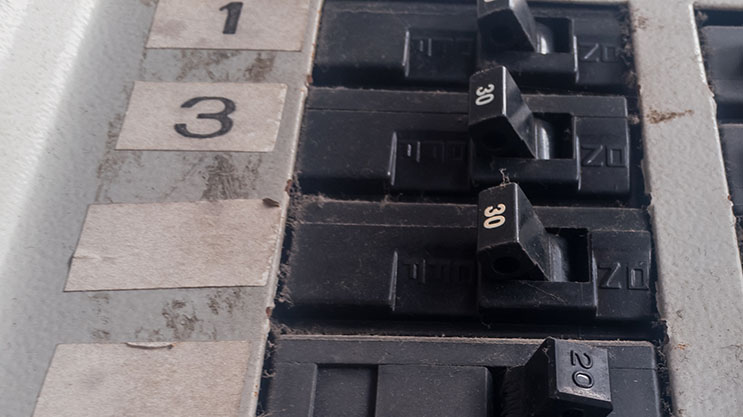
- March 26, 2024
- Electrical Tips
Have you ever had a circuit breaker trip and found that it won’t reset? It’s a common problem, and one that can be frustrating when you’re not sure what to do.
The most common reasons for a circuit breakers that won’t reset are:
- Damaged breakers
- Electrical shorts
- Loose wiring
- Damaged insulation
In this post, we’ll walk you through how to check for each of these common reasons, and discuss how to fix them.
Why circuit breakers trip
A circuit breaker is a safety device in your home designed to stop the flow of electricity if there’s an overload, which can help prevent fires. When the current flowing through the circuit breaker becomes too much for it to handle, it “trips” and shuts off the power to prevent a fire from starting.
Most of the time, resetting a tripped circuit breaker is a simple matter of flipping the switch back to the “on” position. However, sometimes the breaker won’t reset no matter how many times you flip it.
First, try to reset the tripped circuit breaker
First, we should perform a basic test to make sure the breaker is actually malfunctioning. If you haven’t already tried manually resetting the circuit breaker, this is the place to start.
Locate your circuit breaker box and open the cover. Once you’ve located the tripped breaker, flip it to the “Off” position. Then, flip it back to the “On” position. You should hear a click as the breaker resets. If the breaker trips again, or simply won’t reset, there may be a problem with your wiring.
How to fix a tripping circuit breaker
Check to see if the circuit breaker is damaged.
If the circuit breaker trips and won’t reset, the first thing you should do is check to see if the switch is damaged. Circuit breakers are designed to trip when they become overloaded, which means they’re also designed to be flipped back on when the overload is resolved. However, if the switch itself is damaged or the electrical panel is outdated , it may not reset properly.
To check for damage, first make sure that there’s no power going to the breaker box by flipping all the switches to the “off” position. Then open up the panel and visually inspect the faulty breaker for any signs of burned or blackened areas. If you see any charring or burning around the switch, it’s likely time to replace it.
In some cases, you may be able to reset a damaged breaker by gently bending the switch back into place. However, this is only a temporary fix and the breaker will eventually need to be replaced.
We recommend that if you see any damage, it’s best to replace the entire circuit breaker rather than just the switch.
Check to see if there’s an electrical short
Another reason why your circuit breaker won’t reset after tripping is because there’s an electrical short somewhere in your home. An electrical short occurs when there’s too much current flowing through a wire, causing it to overheat and potentially start a fire.
To figure out if there’s an electrical short, the first thing you should do is turn off all of the switches in your breaker box. Once everything is off, go around your home and look for any signs of an electrical fire, such as burning smells or smoke. If you see or smell anything suspicious, call a licensed electrician right away.
If you don’t see any signs of a fire, the next step is to identify which circuit is causing the problem. Start by flipping on one switch at a time and seeing if the breaker trips. If it does, leave that switch off and move on to the next one. Repeat this process until you’ve found the problem circuit.
Once you’ve identified the problem circuit, the next step is to figure out where the electrical short is located. The easiest way to do this is to start at the breaker box and work your way down the circuit until you find the problem.
If you’ve followed these steps and you believe there may be an electrical short, it’s important to call an electrician right away. They’ll be able to locate the source of the problem and fix it before it causes any further damage.
Check for loose wiring
Another common reason for a circuit breaker to trip is because of loose wiring. Over time, wires can loosen and become frayed, which can cause them to short circuit.
The best way to check for loose wiring is to listen to your devices and appliances for the sound of buzzing or crackling. One common culprit is buzzing light switches or outlets. If you don’t find a faulty appliance, note that this can also be true around the breaker.
If you hear these noises and suspect that your circuit breaker is tripping because of loose wiring, the best thing to do is call an electrician as soon as possible. Trying to fix the problem yourself could result in injury or even death.
An electrician will be able to quickly diagnose the problem and make the necessary repairs. In most cases, they’ll also be able to prevent the problem from happening again in the future.
Look for signs of corrosion
Another common reason for a circuit breaker to trip is corrosion. This is especially true if you notice any moisture or wetness in the electrical panel . Corrosion can cause the metal parts of the breaker to break down, which in turn can cause a short circuit.
Corrosion usually appears in the form of a white, chalky substance building up around screw terminals. Look for signs of corrosion, rust, or moisture around the circuit breaker.
If you suspect that corrosion is the culprit, call an electrician to have a look at the problem. Trying to clean or repair the corrosion yourself could result in serious injury.
Check for damaged insulation
Sometimes circuit breakers will have insulation around them to stop cold air from entering through the box itself. Damaged insulation is another common cause of tripped circuit breakers. If you have insulation around the box, inspect it to see if it looks damaged.
If the insulation around your electrical wiring is damaged, it could cause a short circuit. Once again, if you suspect that this is the problem, call an electrician rather than trying to repair the problem yourself.
Is it dangerous if a circuit breaker keeps tripping?
We are often asked if tripping circuit breakers are dangerous. If your circuit breaker keeps tripping, it could be a sign of an electrical problem in your home, up to and including serious fire risks. While it’s not necessarily dangerous if your circuit breaker trips occasionally, if it happens frequently, it should be fixed right away.
If your circuit breaker trips and won’t reset, don’t panic! Many times the problem is something minor that you can easily fix yourself. However, if you’re unsure of what to do or think the problem may be something more serious, always err on the side of caution and call an electrician . Trying to fix the problem yourself could result in serious injury or even death.
Resetting a tripped circuit breaker is a relatively simple process that most people can do on their own. However, if the breaker trips repeatedly or if you have any questions about your electrical system, it’s always best to contact a professional electrician for assistance.
If you have any questions about resetting your circuit breaker or if you need assistance from a professional, don’t hesitate to contact us . We’re here to help!
Latest Articles
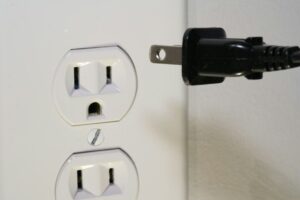
Why Would An Outlet Stop Working? Top 7 reasons, and their solutions

Average Electrician Cost to Install an EV Charger

Light Switch Buzzing: Causes, Dangers, and Fixes

How Many Things Can I Plug Into One Outlet Safely?
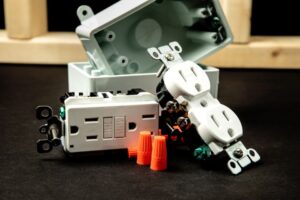
Commercial Outlet Vs Residential Outlets: Which is Right for You?

Are Ungrounded Outlets Dangerous? Understanding the risks

Copyright © 2023 Clocktower Electric, LLC. All rights reserved. St. Simon’s Island, GA 31522
Contact Us | Privacy Policy | Site Map
Light Switch Trips Breaker: What To Do?
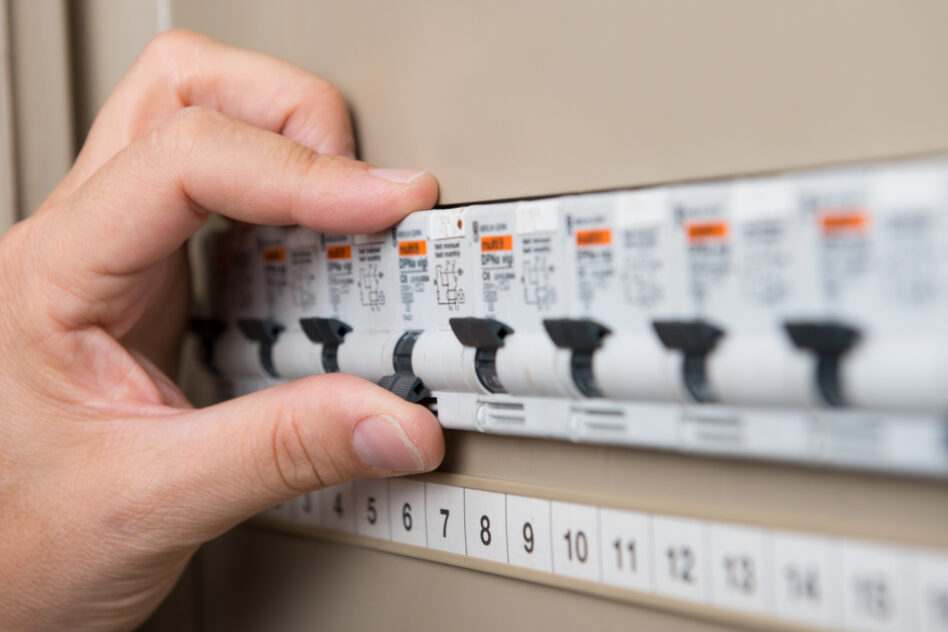
Don’t you just hate it when a light switch trips the breaker? Aside from being annoying, the underlying issues may cause serious damage. What can you do about it, and how to keep it from happening again? Let’s find out!
What Does a Tripped Breaker Look Like?
Get your hands ready, check for water deposition, don’t touch a breaker switch with high amperage, turn appliances and devices off, adjust your circuit breaker, check your breaker panel, know when to call an expert, avoid overloading one circuit, check and replace old wiring, install your light switch properly.
When you open your electrical panel, there should be multiple breakers on a board.
Each of the breakers in the panel regulates a different electrical circuit in your house and has a switch with numbers printed on it. Typically, each one should be labeled with the name of the area that it controls.
Keep in mind that power cannot flow through the circuit until the switch is manually turned back on after a breaker trips. This causes the switch to flip to the “OFF” position automatically.
For example, if the light switch that caused the trip is located in the kitchen, you can easily locate the breaker switch labeled “Kitchen.”
You’ll probably see the “Kitchen” breaker switch tipped to the “OFF” side or right in the middle between “ON” and “OFF.”
What Are the Safety Precautions to Take?
Before we get down to business, let’s make one thing clear: safety is still our top priority.
You may be in a rush to get your problem fixed, but temporarily losing your power supply is so much better than losing an eye or a finger.
Here are some safety tips to keep in mind:
Working on electrical systems with wet hands is extremely dangerous. So, we recommend that you start by drying your hands properly before troubleshooting your light switch.
Then, you can wear protective goggles or use electrical-insulating gloves.
Water won’t always accumulate on the breaker, but it does happen occasionally. That’s why it’s always good to examine your panel carefully. If it seems wet, don’t touch anything.
You might notice a number on the breaker switch that indicates the amps or the measure of electrical current that flows in that circuit.
If the number is 25 or above, it’s better to leave it to the professionals. Meanwhile, if your breakers aren’t labeled at all, it isn’t recommended to attempt to reset them.
Sometimes, simply flipping your light switch can trigger a trip on your circuit breaker.
This is a common issue with newly installed lighting systems. However, circuit breaker trips from flipping a light switch may also be caused by a short circuit due to faulty or damaged wires.
Either way, let’s take a look at how you can approach the tripped breaker.
Start by unplugging all appliances, lamps, and other gadgets in the affected area.
Go to your electrical service panel and check if a particular breaker has tipped to the “OFF” side.
In some cases, the breaker may not tip completely to the “OFF” position and may sit between both sides. When this happens, you can move the switch over to “OFF” first before pushing it back to the “ON” side.
Now, there is a possibility that the switch will automatically tip back to “OFF” after you’ve just switched it to the “ON” side. If that’s the case, don’t try to reset your breaker once more. Instead, seek help from an expert.
After successfully resetting your breaker, flip your light switch to see if the issue is fixed.
If overloading is the culprit, your power will come back after switching your lights on or plugging your devices one at a time.
There may be instances when the light switch doesn’t turn on, but other plugged-in equipment may receive power. If that happens, you can suspect that the problem might have originated from your light switch.
If the previous steps don’t cut it or you’re uncertain about the root cause, it’s best to call your electrician.
Having your breaker trip twice in a row should already sound an alarm, and you shouldn’t try to fix the problem on your own.
The primary concern here is that repeatedly resetting your breaker due to recurrent trips can be risky and may result in overheating.
After all, serious complications and accidents are on the line, including the following hazards:
- Overheating of internal components that may lead to fires
- Visible damages like scorch marks on power outlets, sometimes with the presence of a burning smell and smoke
- Sparks on the breaker
- Odd clicks or buzzing sounds from the outlets or switches
How To Prevent Your Light Switch From Tripping the Breaker?
Since dealing with a light switch that trips the breaker is a hassle, you might want to check out these preventative tips and tricks:
Circuit overload is the main reason behind trips. That’s why it’s better to avoid plugging your bulb into one circuit with a ton of connected appliances.
Remember that using an extension cord to maximize connectivity will only make things worse. If you badly need to use multiple devices, try plugging your other devices into a different circuit connection or getting a new circuit installed.
Be sure to unplug devices or appliances that aren’t in use.
If your electrical wires have been sitting there for many decades and you start to experience frequent trips, they’re probably worn out.
You might even notice that rodents have damaged your wiring. So, it’s good to have your old wires replaced by an electrician.
We’d recommend double-checking that you’re using compatible fixtures before installing new lights or replacing any part of the lighting setup.
Then your electrician can check that all screws are all tight and wirings are connected properly to reduce the risk of tripping.
Related Articles

Why Are My LED Lights Two Different Colors?

Can You Change the Color of LED Lights?

What’s The Difference Between LED and LASER Diode?
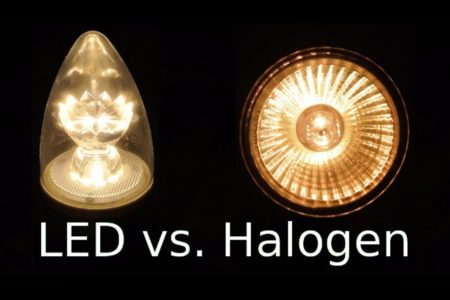
LED vs. Halogen bulbs – What’s the difference? Which is better?
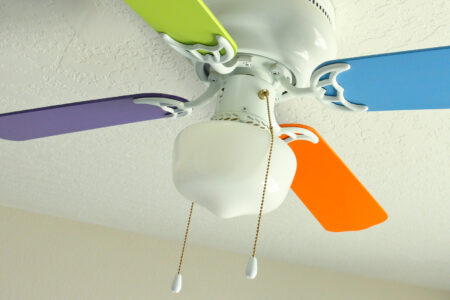
Can You Use A Dimmer Switch On A Ceiling Fan?

Is Recessed Lighting Outdated in the 21st Century?

Circuit Breaker Tripping: Troubleshooting Guide
Hubert Miles | Licensed Home Inspector, CMI, CPI
Updated on January 5, 2024

A circuit breaker tripping results from short circuits, overloaded circuits, and ground faults. In each case, an unintended excessive flow of current triggers the trip. You must reset the circuit breaker by flipping it back on to restore power.
Circuit breakers trip because they cannot handle the amount of current running through them. Tripping the circuit breaker interrupts the flow of electricity and protects your devices or appliances from damage.

Get FREE estimates from licensed electricians in your area today. Whether you need to replace an outlet, hang a ceiling fan, a new electrical panel, or repair wiring, We Can Help!
Without electrical circuit breakers , the possibility of electrical fires would be much higher.
This guide looks at what causes circuit breakers to trip, what you can do, and how to identify a bad breaker.
What Would Cause a Circuit Breaker to Trip
There are three leading causes of circuit breaker trips:
- circuit overload
- electrical faults (i.e., ground faults and arc faults)
- short circuits
Below are factors that can cause circuit breaker trips.
Circuit Overload
A circuit overload happens when the flow of electric current running through the circuit exceeds the amperage of the devices it serves.
For example, if your microwave is a 12.5 amp appliance, you can run it on a 15 amp circuit. That means your microwave is safe as long as the amperage running through the circuit is 15 amps .
However, if the circuit receives an excessive electrical load over 15 amps , it will automatically trip to protect your device from damage. If the circuit doesn’t trip, the excess current will fry the circuit in your microwave.
Also, if you operate too many appliances and devices on one circuit, its internal mechanism heats up, causing the breaker to trip.
Circuit overload is the most common reason for breakers tripping.
Ground Faults
A ground fault occurs when the active wire comes into contact with a ground wire made of bare copper. Sometimes, this fault may happen when the hot wire touches the metal box connected to the ground wire.
Excessive current flows once the active wire touches the ground wire, flowing into the earth. If you step on the affected area, ground faults can cause shock and even electrocution. The uncontrolled flow of electricity will cause the circuit breaker to trip.
Arc Faults
An arc fault happens when exposed faulty wiring touches, causing the electric current to arc at the meeting point. As a result, sparks occur, which can ignite an electric fire.
A corroded or loose connection is the main culprit for arc faults. Circuit overloads, ground faults, or short circuits trip an AFCI (Arc Fault Circuit Interrupter) circuit breaker.
Arc faults result from damaged, loose, or corroded terminals and wires. The arc fault builds up over time as the heat due to the cable damage and terminals build up to the point of ignition.
Short Circuits
A short circuit occurs when an active wire touches a neutral wire, and the electrical current takes an unintended path of least resistance.
The common cause of short circuits is frayed wires coming into contact when the wires touch. The electrical current flow increases significantly, causing the circuit breaker to trip to stop the electricity from damaging appliances.
It is a short circuit because the current bypasses the proper circuit wiring channels and flows through a shorter, unplanned pathway.
Short circuits occur
- When insulation melts and wires are exposed
- Within appliances with damaged internal wiring
- Due to damaged and frayed extension or appliance cords
How do You Fix a Breaker that Keeps Tripping?
A dedicated circuit breaker tripping indicates too much current flowing through the wiring or connection to the outlet.
Here is a step-by-step guide to follow when you notice the first trip:
- Begin by turning off all the appliances and unplug electrical devices from the outlet. Also, switch off light fixtures and unplug those that you can. This prevents any appliances from damaged when the breaker is reset and a sudden surge of power comes through.
- Open the circuit panel or box and locate the on and off buttons of the circuit breaker. You may notice an orange or red color on the breaker when it is off.
- Flip the switch from off to on to reset the circuit breaker. Once the breaker is reset, you can switch and test the appliances to see if the electrical power is flowing.
- Keep safe as you reset the breaker by working from the side of the electrical box instead of the front. That way, you will avoid any sparks (should there be any) when you switch the breaker back on.
- Some people prefer to switch the main electrical switch when working on the circuit breaker for added safety.
Types of Circuit Breakers
Standard circuit breaker.
Standard circuit breakers monitor the modulation of the electric current coming into your devices and appliances.
This circuit breaker stops the current from flowing when it detects the excessive flow of electricity.
Standard circuit breakers come in two forms:
- Single-pole circuit breakers
- Double pole circuit breakers
Single-Pole Circuit Breakers
Single-pole circuit breakers are the most common breakers in homes and buildings. They monitor the electric current’s flow in one wire and trip if that wire experiences a very high influx of electricity.
These breakers deliver only 120 volts and work well for 15 to 30 amp circuits. Single-pole circuit breakers come with one switch in the back.
Double-Pole Circuit Breakers
The double-pole circuit breakers monitor the current in two wires simultaneously. You will notice two switches on the back of these breakers.
The double-pole circuit breakers will trip even if only one of the wires receives too much current. They can accommodate between 15 to 200 amps while delivering 240 volts.
Single-pole breakers are a good fit for lighting fixtures and other standard home outlets. On the other hand, double-pole breakers work for larger appliances like dryers and washing machines.
Ground Fault Circuit Interrupter (GFCI)
The GFCI circuit breaker interrupts the line due to ground faults. They trip when the current starts to follow an uncharted path into the ground. These ground fault surges occur when a foreign conductor, like water, comes in contact with a receptacle .
At the same time, they offer protection against circuit overloads and short circuits.
GFCI circuit breakers come built into specialized outlets required for wet areas in the home, including :
- Outdoor areas like the balcony, patio, porches, and decks
- Laundry rooms
- Swimming pools
- Six feet from a sink
- Six feet from the bathroom
These breakers help prevent shock or electrocution should the electrical outlet contact water.
Arc Fault Circuit Interrupter (AFCI)
The AFCI circuit breaker detects normal and abnormal arc faults, so it will trip when it detects a dangerous arc fault that can cause a fire.
The AFCI circuit breaker doesn’t work to protect devices and appliances plugged into an outlet. It works to prevent electrical fires due to faulty connections and wiring. The internal sensing mechanism in the circuit breaker senses the conditions of an electric arc, and the circuit trips to avoid an electric fire.
AFCI protection can also be built into an outlet. The National Electrical Code (NEC) requires these types of breakers to feature in :
- Common rooms
- Laundry areas
AFCI and GFCI circuit breakers can co-exist and complement each other for the best protection.
Combination All Fault Circuit Interrupter (CAFCI)
The CAFCI breaker senses and reacts to any electrical fault, including ground and arc faults.
CAFCI is a relatively new technology that meets new NEC requirements for circuits requiring arc and ground fault protection.
Do Circuit Breakers Get Weak?
A circuit breaker can wear out and become weak. If a breaker trips frequently, the thermal or magnetic element can lose calibration, causing it to trip at lower amp loads than intended. A breaker constantly under thermal stress caused by overloading the circuit will eventually trip more frequently.
Let’s not forget breakers are not impervious to damage. As the internal mechanical parts wear out, they become very sensitive and may not hold under normal load amperage and temperatures.
Electricians refer to this as a bad breaker .
Will a Bad Breaker Keep Tripping
By definition, bad breaker malfunctions, so it will keep tripping until it is either replaced or rectified .
A licensed electrician performs this simple test to see if a breaker will keep tripping and determine if it can be repaired or replaced in the following steps.
- The electrician will switch off all the fixtures and appliances in the house. Also, unplug everything.
- Find the malfunctioning circuit breaker . The electrician will go to the electrical box and locate the breaker lighting orange or red or the one with the switch off.
- They will ascertain that it is the correct circuit breaker. After that, the electrician puts the breaker off.
- With the switch on, the breaker is back on as well. The electrician will plug the appliances into the outlet with the problem circuit breaker. Now, they will turn the devices and appliances on.
If the breaker trips, the electrician will investigate the circuit’s current amount. The breaker is bad if the current is according to the appliance’s rating.
How You know if a Circuit Breaker is Bad
Breakers do wear out after a while. It has a problem if the breaker doesn’t stay on after resetting it.
Since the circuit breaker controls the electric flow in the house, it is essential to monitor it and catch signs that it has gone bad early.
Here are key signs that denote a bad circuit breaker :

It Frequently Trips
Frequent tripping could be because of a bad breaker. After tripping and resetting, your circuit breaker should stay on unless it detects high current flow.
To ensure that the issue is not the electricity but the circuit breaker, call an electrician to examine your electricity’s flow and determine whether it is the cause of the constant tripping.
If it is not, then the circuit breaker is the problem.
The Breaker Overheats
Electrical systems will heat up when active. Typically a breaker can heat to about 60°C (140°F) before problems arise.
Terminations for standard rated breakers: UL 489 Paragraph 7.1.4.2.2 says the temperature rise on a wiring terminal at a point to which the insulation of a wire is brought up as in actual service shall not exceed 50°C (122°F). Terminations for 100% rated breakers: UL489 Paragraph 7.1.4.3.3 says the temperature rise on the termination shall not exceed 60°C (140°F). Handles, knobs, and other user surfaces: UL489 Paragraph 7.1.4.1.6 says the maximum temperature on handles, knobs, and other surfaces subject to user contact during normal operation shall not exceed 60°C (140°F) on metallic and 85°C (185°F) on nonmetallic surfaces. Source: https://www.clipsal.com/faq/fa173839
Call an electrician immediately if the breaker becomes too hot.
There are Scorch Marks
Scorch marks around receptacles, appliances, and the electrical box should tell you your circuit breaker has gone bad.
The burn marks indicate that wiring insulation has melted off and the circuit wires are now sparking and emanating heat or fire. That means that the circuit breaker did not interrupt the excess current and reached the wires and burned them.
You may see melted wire sheathing on the wire where it connects to the breaker.
Professional electricians can use a thermal imaging infrared camera to locate the heat source. The infrared camera allows them to pinpoint the problem area through the walls and other construction material.
A Burning Smell
Sometimes you may smell the insulation burning, but no scorch marks are present to denote which outlet is the problem.
With the help of the infrared camera, an electrician can help locate electrical issues.
If you encounter a burning odor, shut off the main power and call for emergency service from an electrician.
The electrical wires burn because power surges through the circuit, melting the wire insulation.
What is Nuisance Tripping
Nuisance tripping is when a breaker trips without a fault to warrant the interruption to the electric current flow.
Nuisance tripping occurs due to several reasons:
Stringent Protection on Circuits
Sometimes the circuit is protected by stringent conditions that detect any variance as a fault and cause a trip.
Such stringent conditions can be tuned to accommodate the home’s or building’s electric needs.
A Highly Sensitive Circuit Breaker
In some cases, the circuit breaker has been set to susceptible settings so that they can detect even the slightest fault, even a minor average variance.
For example, the manufacturer can set an AFCI circuit breaker to sensitive standards to detect another circuit’s arc. This common issue may occur in a daisy chain where the circuit breakers connect in a linear series. There may be a faulty electrical outlet you are unaware of on the circuit. It is common for multiple rooms to share a breaker in older houses.
The Breaker Encounters Power Under Different Conditions
The variation in the current is normal, but the breaker responds to it by tripping because the flow is outside the breaker’s regular operation.
Your circuit breaker is tripping because the voltage it is encountering is not within the standard operation. You will need to adjust the circuit breaker or the voltage to eliminate nuisance tripping.
The Breaker Trips with Nothing Plugged in
A breaker tripping with nothing plugged in occurs when a hot, neutral wire is touching somewhere in the circuit. The common causes include frayed or damaged electrical wires, loose connections, faulty electrical receptacles, light switches , or dimmers.
Electrical wire damage happens when:
- wiring is chewed by animals such as rats, squirrels , raccoons, etc
- wire sheathing and insulation ages and become frayed
- wires rub against sharp edges such as punch-outs with missing grommets or wire clamps
Loose connections often occur when electrical wire nuts come loose or electrical tape wears out causing wires to touch.
Defective wiring can be anywhere along the circuit, so it’s best to contact a licensed electrician to troubleshoot why the breaker is tripping.
Replacing a Bad Circuit Breaker
- Check the electrical panel to see the compatible approved circuit breaker brands. Also, make a note of the brand of the electric panel . This is to help you determine if there are upgrades they could recommend for the hardware.
- Order online or go to the hardware store and purchase the breaker of the same voltage as the one you are replacing.
- Go and open the electrical box and switch off the bad breaker. Loosen the terminals and remove the wires using a pair of needle-nosed pliers. Ensure the pliers have rubber insulated handles to avoid shock or electrocution since you will use the pliers to grab the live wires from the terminal. That is a safety measure.
- Remove the bad breaker. Replace it with the new breaker and slip its clips into place. Remember to switch off the replacement breaker.
- Next, using the pliers, hold the wiring and tighten the screws on the terminal. It is crucial to ensure that the wires and screws in the terminals are in the right place.
- Turn the breaker on and replace the electrical panel cover.
Can a Breaker Fail Without Tipping
If you have a newer electrical panel , it’s not likely for a breaker to fail and not trip. However, in older breaker boxes like Federal Pacific , the breaker failing to trip is common.
The main reason Federal Pacific was investigated by the Consumer Products Safety Commission (CPSC) was widespread structure fires involving breakers failing to trip when an electrical overload was present. They found that the circuit breaker contacts would fuse to the bus bar.
Modern breakers will trip when a failure occurs as an added layer of safety. Most older breakers did not have these safeguards.
With AFCI breakers, if the Internal sensing mechanism fails, the breaker reverts to a standard breaker. The AFCI sensor mechanism will no longer work, but the breaker would still trip from overcurrent protection. Therefore, you should test the AFCI breaker regularly.
Conclusion
Listen to your circuit breaker . It’s alerting you of a problem when it trips. That communication could be a problem with the breaker itself, the circuit, or the amount of electric current coming into your home.
Hubert Miles is a licensed home inspector (RBI# 2556) with more than two decades of experience in inspection and construction. Since 2008, he has been serving South Carolina through his company, Patriot Home Inspections LLC. As a Certified Master Inspector, Hubert is dedicated to providing his expertise in home inspections, repairs, maintenance, and DIY projects.
Continue Reading

Watts to Amps Calculator: DC/AC Wattage to Amps Conversion

70 Amp Wire Size: Breaker & Wiring Gauge Guide

80 Amp Wire Size: Breaker & Wiring Gauge Guide

200 Amp Wire Size: Service Length & Wiring Gauge Guide

10/2 or 10/3 Wire for Mini Split: A Professional Guide

GFI vs GFCI: Understanding the Key Differences

Founded by Hubert Miles, Certified Master Inspector
Home Inspectors
Calculators
Privacy Policy
Terms of Service
©2024 Home Inspection Insider 898 Whispering Pines Rd, Johnsonville, SC 29555 843-250-1882
How to Reset a Tripped Breaker
What to do when a circuit breaker trips.
Lee has over two decades of hands-on experience remodeling, fixing, and improving homes, and has been providing home improvement advice for over 13 years.
:max_bytes(150000):strip_icc():format(webp)/headshots_FINAL_lee-wallender-739d21a7b6ed4aa1b895c684e193494c.png)
The Spruce / Kevin Norris
What Causes a Tripped Circuit Breaker
Safety considerations, how to avoid tripped breakers, when to call a professional.
- Total Time: 5 mins
- Skill Level: Beginner
- Estimated Cost: $0
A power breaker trip is an annoying occurrence when the power shuts off and you can't use the microwave, lights, or router. A breaker trip is far more than simply annoying when you need that router to send off a time-sensitive work assignment or when medical devices are diverted to time-limited standby power. Fortunately, it's easy to fix a circuit breaker trip in just a few minutes.
Tripped Circuit Breaker
A tripped circuit breaker is when a circuit breaker automatically shuts off to prevent devices on the circuit from overheating or from receiving excessive power. A circuit breaker protects your home against damaging or harmful short circuits and overloads.
- Overloaded circuits : When too many devices are operating on the same circuit and are attempting to pull a higher power load than the circuit can carry, the circuit breaker will trip.
- High-power devices : High amp devices like microwaves , dryers , wall heaters , or A/Cs are turned on for sustained periods, they can cause a power breaker trip.
- Short circuits : In a short circuit, a powered or hot wire makes contact with a neutral wire or when wires are loosened .
- Ground faults: In a ground fault, a hot wire touches anything that is grounded, such as the side of a metal electrical box , an appliance, an outlet , or a bare ground wire.
Need more help? Talk to an electrician near you
Our partners can help you compare quotes from top-rated professionals near you
Get a Quote
Watch Now: How to Safely Reset a Tripped Circuit Breaker
Working around an electrical service panel or circuit breaker board can be dangerous. Your home’s entire electrical load is contained in that box, concentrated around the metal lugs where the service drop’s wires enter the box. Unscrewing and removing the inner dead-front cover within the service panel exposes the highly powered lugs.
What You'll Need
Equipment / tools.
- Circuit breaker directory (if available)
- Rubber-soled shoes
- Safety glasses
Instructions
Locate a flashlight.
Circuit breaker panels tend to be located in out-of-the-way locations with little, if any, ambient light. Find a flashlight. Use the light from a phone if necessary.
Turn Off Devices on the Circuit
Turn off all devices on the electrical circuit. This includes the device that may have caused the breaker to trip, such as a microwave, hairdryer, or A/C, plus all other devices on the same circuit.
Find the Electric Service Panel
The electric service panel, sometimes called a circuit breaker board, is a metal box with a door. The box may be inset in a wall, its face flush with the wall, or surface-mounted where the entire box is exposed.
Places to look: garage , closet, pantry near the kitchen, basement , mudroom, hallway leading to garage or backyard.
One clue is to first find the electric service drop from the main power lines. Usually, your home’s service panel is located below and nearby, on the inside of your home.
Open the Door to the Service Panel
Open the door to the service panel by sliding the plastic switch to the side or up. Next, swing the door open. Use the inset plastic switch as a handle to pull the door open.
Adhi Syailendra / Getty Images
Locate Tripped Breaker
The handle of a tripped circuit breaker should be in the middle position—not left or right. Visually or by feel, locate any breaker handles that differ from the right or left positions:
- Tripped breakers : Tripped circuit breakers have a soft or springy feeling when you lightly press them leftward or rightward.
- Live/active breakers : Breakers that are not tripped are either firmly left or right (depending on which side of the box you're looking at).
Certain breakers, such as Eaton breakers , trip to the off position, not the middle position. Check manufacturer's instructions for your particular product.
Turn the Circuit Breaker Handle to OFF Position
Flip the circuit breaker handle to its firm OFF position, toward the outer edge of the service panel (away from the centerline).
Double and Tandem Breakers
Double pole breakers are double-wide breakers with wide handles. They are often used for dryer or oven circuits. Both sides of double pole breakers operate as one. Tandem breakers are two narrow breakers that share the space of one breaker. Each side operates individually.
Turn the Circuit Breaker Handle to ON Position
Flip the circuit breaker handle to its firm ON position, toward the centerline of the service panel. The handle should seat firmly in place and should make an audible click.
Test Circuit
Turn the device such as the light or A/C back on. If you believe the breaker tripped due to an overload, it’s best to turn on only one device at this time, not multiple devices. Also, choose a device with a lower power draw such as a light fixture.
- Remove some devices from the overloaded circuit and plug them into other circuits that aren’t drawing as much power.
- Avoid running many devices on the circuit at the same time. In a kitchen , for example, stage cooking activities that require power so that they happen in succession, not all at once.
- Install GFCI outlets so that the outlet shuts off before the entire circuit breaker shuts down in the case of a ground circuit. Just note that GFCI outlets are not circuit overload protection, but protection against dangerous ground faults.
- Replace old outlets, light fixtures, and switches which may create short circuits or trip breakers.
- Have an electrician separate hardwired devices that are drawing too much power from a single circuit. The electrician can move devices to another circuit or can set up an entirely new circuit to relieve the load.
- Replace the circuit breaker.
A qualified, licensed electrician is trained to detect the cause of tripped breakers and to fix those causes. If your problem of tripped circuit breakers is more than just an overloaded circuit, you may want to seek the help of an electrician. Unless you are an advanced do-it-yourselfer , it’s best to hire an electrician to wire up a new circuit breaker .
Electrical Panel Safety . Office of Congressional Workplace Rights.
CH Circuit Breakers . Eaton.
Ground-Fault Circuit Interruptors . International Association of Certified Home Inspectors.
More from The Spruce
- GFCI Receptacle vs. GFCI Circuit Breaker
- Ground Fault vs Short Circuit: What's the Difference?
- Calculating Electrical Load Capacity for a Home
- Understanding Arc Faults and AFCI Protection
- What Happens When a Fuse Blows
- Line vs. Load Wiring: What's the Difference?
- Subpanels Explained for Home Owners
- How Much Does an Electrician Really Cost? We Break It Down by Service
- A Basic Guide to Home Electrical Wiring
- Understanding Fuses and Fuse Boxes
- How to Reset a Circuit Breaker
- Amps vs. Volts: The Dangers of Electrical Shock
- How to Wire a Single-Pole Light Switch
- What Is a Short Circuit, and What Causes One?
- Line or Load With GFCI Connection
- Inside Your Main Electrical Service Panel
- Account Settings
Home Services
- Home Security
- Pest Control
- Living Room
- Other Rooms
- Home Improvement
- Cost Guides
- Floor Plans
Housekeeping
- Cleaning Tips
- Organization
- Popular Brands
- Sizes & Dimensions
Smart Living
- Dangerous Areas
- Safest Areas
- Most Affordable Areas
Top stories

Why Does My GFCI Trip When I Turn On The Light Switch?

Ground Fault Circuit Interrupters, or GFCIs, are a necessary safety measure in modern times. They can prevent harmful ground faults that can cause dangerous and expensive electrical problems. So, why does my GFCI trip when I turn on the light switch?
Your GFCI will trip when you turn on a light switch if the neutral connection and ground are tied. The GFCI trips because it recognizes a drop in voltage that can be potentially dangerous as a safety precaution. If the light switch sends out 120 volts and gets nothing back, the GFCI will trip and shut off.
Never take it lightly if your GFCI trips when you turn on the light switch. Call a professional electrician if this happens so that they can diagnose the problem and repair it if necessary. Follow along as we explore why your GFCI trips when you turn on the light switch.
Do You Need to Hire an Electrician?
Get free, zero-commitment quotes from pro contractors near you.

Why Does My GFCI Trip When I Turn on the Light Switch?
A GFCI trips when you turn on the light switch if doesn’t receive the same voltage that it sends out . Many switches send out 120 volts, and they are supposed to receive 120 volts back. However, the GFCI will trip if it receives nothing back as a safety precaution.
This can also happen if the neutral connection is tied to the ground connection because that is dangerous. That can cause serious electrical problems and potentially start a fire if the GFCI doesn’t trip. A GFCI protects any switch or outlet connected to it and will trip if there is any inconsistency in voltage.
Any Ground Fault Circuit Interrupter on the same circuit as a switch or similar fixture will trip if there are voltage problems. GFCIs exist as a safety measure to interrupt a ground fault within 1/40 of a second .
What is the Point of a GFCI?
The primary purpose of a GCFI is to prevent electrocution. Every electrical outlet is designed to deliver and receive the same amount of voltage. If the hot wire (black wire) delivers 120 volts, then the neutral (white wire) must also send 120 volts back to the source. What if this doesn’t happen?
Suppose you have a corded skill saw. The cord is frayed, but you don’t notice the issue upon plugging in the tool. If you touch the hot wire in the cord, the electrical current will pass through you in its attempt to return to the ground.
If the tool is plugged into a GFCI, all you’ll receive is a small (but alarming) shock. The GFCI sensed that the neutral wire wasn’t carrying 120 volts back to the receptacle. As such, the GCFI opened the circuit in a fraction of a second, terminating the flow of electricity to both the tool and yourself.
GFCI Components
Ground Fault Circuit Interrupters consist of 5 simple components despite the advanced function. A GFCI can fail if any of the components come loose or suffer damage. That is why it is important to install them correctly or hire a professional electrician to avoid problems.
- Two brass screw terminals on the right side for hot-wire connections.
- Two silver screw terminals on the left side for neutral-wire connections.
- One green screw terminal on the left side for a grounding connection.
The chief difference is that a GFCI has a “line” side and a “load” side. GFCI line sides are where you connect the incoming source of power. The load side is where you connect the outgoing source of power.
Importantly, the load side consists of the top two screws on either side of the GFCI (one brass and one silver). The line side consists of the bottom two screws on either side of the GCFI. Each component must be perfectly in line so that the GFCI can quickly trip in the event of a ground fault or voltage drop.
How To Install A GFCI
If you’ve installed a standard receptacle, you can probably install a GFCI. For simplicity’s sake, let’s say you want to connect a standard receptacle with a GFCI:
- First, differentiate the cable serving the line end of the GFCI from the cable serving the load end of the GFCI. The line end will originate from the electrical panel.
- Strip the sheathing from the cable and the insulation from the ends of all the wires. Cut the wires back if necessary.
- Join the hot (black), neutral (white), and ground (bare copper) together in a pig tail. You should have two wires connected.
- Take a bit of black, white, and ground wire, and tie them into the pig tails you made in the previous step, securing all three connections with wire nuts.
- Take the open ends of the third wires, and connect them to the appropriate terminals on the GFCI: bare copper goes to the ground connection below the GFCI’s plug, the neutral connects to the silver line end, and the hot connects to the brass line end.
What you’ve done is create a circuit in which the downstream standard receptacle is unprotected. Why? Because the load portion of the GFCI is not connected to the wires traveling to the standard receptacle. They’re just pigtailed together.
In the event that you do want to protect the standard receptacle with the GCFI, simply remove the wire nuts on the neutral and hot wires. Get rid of the third wires you used to connect the spliced wires to the GFCI, and connect the wires going to the second outlet to the load terminals on the GFCI. Simple as that.
Venturing into anything more complicated than this is definitely an electrician’s territory. Attention to detail is imperative . Especially if you’re using junction boxes to connect multiple fixtures and receptacles to a single GFCI.
Related Articles
- Surge Protector vs. GFCI: Which Outlet is Safer and Better?
- Can Two GFCI Outlets Be On The Same Circuit? (Find Out Now!)

We are a team of passionate homeowners, home improvement pros, and DIY enthusiasts who enjoy sharing home improvement, housekeeping, decorating, and more with other homeowners! Whether you're looking for a step-by-step guide on fixing an appliance or the cost of installing a fence, we've here to help.
More by Upgraded Home Team

How To Stop Creeping Charlie From Spreading
Popular articles.

What To Do If There Is A Snake In The Pool

What Do I Do If A Groundhog Keeps Eating My Plants

Why Are Bugs Coming Out Of My Drain?

11 Uses For A Dehumidifier You Might Not Know
You may also be interested in.
![circuit breaker trips when i turn on light The 5 Best Angle Grinders – [2022 Reviews & Buyer's Guide]](https://cdn-fastly.upgradedhome.com/media/2023/07/31/9071326/the-5-best-angle-grinders-2022-reviews-buyer-s-guide.jpg?size=350x220)
The 5 Best Angle Grinders – [2022 Reviews & Buyer's Guide]
![circuit breaker trips when i turn on light 10 Best Electric Lawn Mowers - [2022 Reviews & Top Rated Models]](https://cdn-fastly.upgradedhome.com/media/2023/07/31/9070486/10-best-electric-lawn-mowers-2022-reviews-top-rated-models.jpg?size=350x220)
10 Best Electric Lawn Mowers - [2022 Reviews & Top Rated Models]
![circuit breaker trips when i turn on light 10 Best Electric Pressure Washers – [2022 Reviews & Guide]](https://cdn-fastly.upgradedhome.com/media/2023/07/31/9070600/10-best-electric-pressure-washers-2022-reviews-guide.jpg?size=350x220)
10 Best Electric Pressure Washers – [2022 Reviews & Guide]

My TV Is Above The Fireplace: Where Do I Put The Cable Box?
![circuit breaker trips when i turn on light How Much Weight Can a 4×4 Support Horizontally? [It Depends!]](https://cdn-fastly.upgradedhome.com/media/2023/07/31/9070333/how-much-weight-can-a-44-support-horizontally-it-depends.jpg?size=350x220)
How Much Weight Can a 4×4 Support Horizontally? [It Depends!]

Ways to Fix Nest "No Power to Rh Wire" (Do This!)

How Many Amps Does A Refrigerator Use? (According To Its Size)

14 Worst Refrigerator Brands To Avoid (and Most Reliable Brands)

How To Fix Loose Washing Machine Drum (Do This!)

How Many Watts Does A Well Pump Use? (Find Out Now!)

TV Keeps Going Black For A Few Seconds? (Possible Causes & Fixes)

How To Move A Front Load Washer Without Shipping Bolts (Do This!)
![circuit breaker trips when i turn on light 12 Washing Machine Brands to Avoid [with Recall Data]](https://cdn-fastly.upgradedhome.com/media/2023/07/31/9075781/12-washing-machine-brands-to-avoid-with-recall-data.jpg?size=350x220)
12 Washing Machine Brands to Avoid [with Recall Data]

How To Tell If An Outlet Is 110v Or 220v (Find Out Now!)

How To Run A Propane Line From The Tank To The House (Do This!)

Is Your Bosch Dishwasher Wet Inside? (We Have a Fix!)

Symptoms Of A Bad AC Capacitor (Here Are 7 Telltale Signs)

Garage Door Won't Close Unless You Hold The Button? (Fix It Now!)
Light Switch Trips Breaker When Turned Off | Causes and Solutions
Light switch tripping breakers even when turned off might be one of the irritating problems to deal with while working on electrical issues. Even though it is not a common occurrence, it does occur, especially in older construction residencies.
In this informative article, we will dive into the root causes of this issue and provide practical solutions to resolve it.
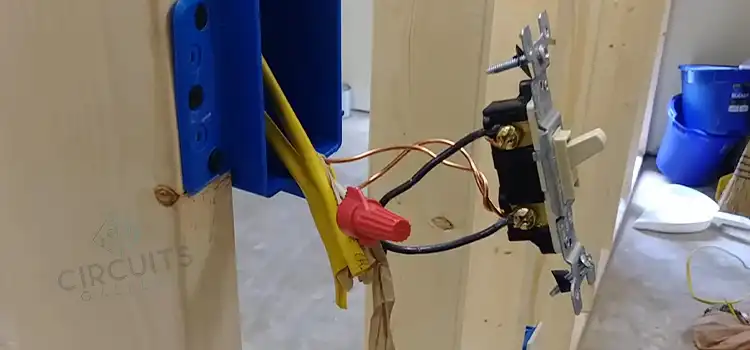
- Why Does Your Light Switch Trip the Breaker When Turned Off?

Figure: Tripped Breaker
There might be several reasons behind this dilemma, such as faulty wiring, defective switches, or the circuit being overloaded when the light is turned on.
Faulty Wiring
Faulty components and wiring are one of the primary causes behind this problem. If there is a fault in the wiring that results in a short circuit, it will cause the breaker to trip for safety reasons.
Consult a qualified electrician to inspect and repair this issue. If you’re not confident enough, you should not engage in tinkering with electrical wiring, which may lead to a disaster.
Defective Switch
The problem may lie in the switch itself. If the switch is old, broken, or malfunctioning, it may cause abnormalities when turned off.
If you detect any faulty switch, immediately replace the faulty switch with a new one. However, make sure the new switch is compatible with your electrical system and installed correctly.
Loose Connections
Loose electrical connections often result in breaker tripping. Improper and faulty connections can become loose due to a long time usage causing wear, tear or improper installation.
Proper maintenance and inspection of all the connections are necessary to avoid loose connections. If any loose connections are discovered, tighten and ensure they are properly secured.
Overloaded Circuit
If a circuit contains too many electrical devices, it draws more current than it can handle. The breaker can trip even when a switch is turned off.
If your electrical circuit is not distributing current properly, reconfigure and reduce the number of loads if needed.
Breaker Malfunction
There might be cases where the breaker is faulty, leading to unintentional trips.
Replace the breaker with a new one if you find that the breaker is faulty.
- To Conclude
Whenever you’re dealing with electrical issues, safety should be the top priority. Under any circumstances, do not troubleshoot or repair any electrical circuit if you’re unsure about the problem. Make sure to check if the runner creates a short circuit to the neutral or ground wire . Consult a qualified electrician in case you’re skeptical about the solution.
Subscribe to our newsletter
& plug into
the world of circuits
Share this content

A seasoned electronics enthusiast, Charles Clark is a key contributor to Circuits Gallery. From basic components to advanced microcontroller projects, Charles simplifies complex concepts with ease. His writings are a blend of expertise and passion, making electronics accessible to all. Whether it's circuitry or digital communication, Charles is the voice you can trust.
Similar Posts
![circuit breaker trips when i turn on light Can A Bad Breaker Cause Low Voltage [Answered]](https://www.circuitsgallery.com/wp-content/uploads/2023/09/Can-A-Bad-Breaker-Cause-Low-Voltage.webp)
Can A Bad Breaker Cause Low Voltage [Answered]
Yes, a faulty circuit breaker can, perhaps, cause low voltage issues in an electrical system. A circuit breaker may of course malfunction or deteriorate over time. And in that case, the breaker becomes unable to properly handle the electrical load….
![circuit breaker trips when i turn on light What Are The 3 Wires On A Microwave Transformer [Answered]](https://www.circuitsgallery.com/wp-content/uploads/2023/11/What-Are-The-3-Wires-On-A-Microwave-Transformer.webp)
What Are The 3 Wires On A Microwave Transformer [Answered]
Microwaves have become an indispensable part of our daily lives, serving up quick and convenient meals with the touch of a button. One such crucial component in a microwave is the transformer, and within it, we find three wires that…
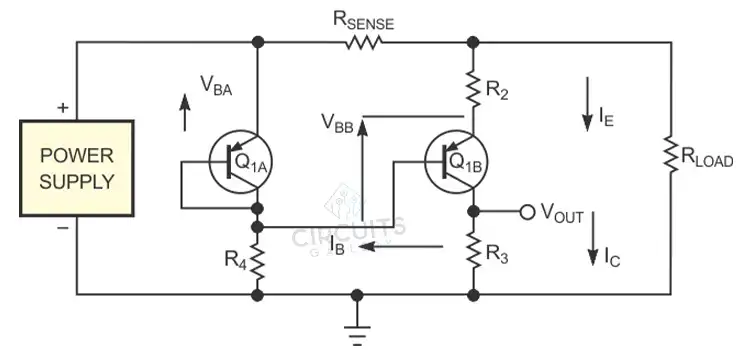
What Is the Current Through the Transistor | PNP and NPN Transistors
A transistor is a semiconductor device that conducts and insulates electric current or voltage. This active component serves both as a switch and an amplifier. The most prominent application of a transistor is its utilization in controling or regulating the…
![circuit breaker trips when i turn on light Which Amplifier Is Best Transistor or MOSFET? [Compared and Explained]](https://www.circuitsgallery.com/wp-content/uploads/2023/07/which-amplifier-is-best-transistor-or-mosfet.webp)
Which Amplifier Is Best Transistor or MOSFET? [Compared and Explained]
While BJT shines in low frequency, MOSFET works best in high-frequency amplifiers. A transistor and a MOSFET (Metal-Oxide-Semiconductor Field-Effect Transistor) both have their benefits and are appropriate for different applications. For an amplifier, the use of BJT and MOSFET depends…
![circuit breaker trips when i turn on light What Causes a Capacitor to Explode? [6 Reasons]](https://www.circuitsgallery.com/wp-content/uploads/2023/06/What-Causes-a-Capacitor-to-Explode.webp)
What Causes a Capacitor to Explode? [6 Reasons]
Reverse polarity voltage and over-voltage are the two main factors that can make a capacitor explode. Compared to other types of capacitors, electrolytic capacitors are more likely to explode. In the following piece, we shall explore the primary factors contributing…
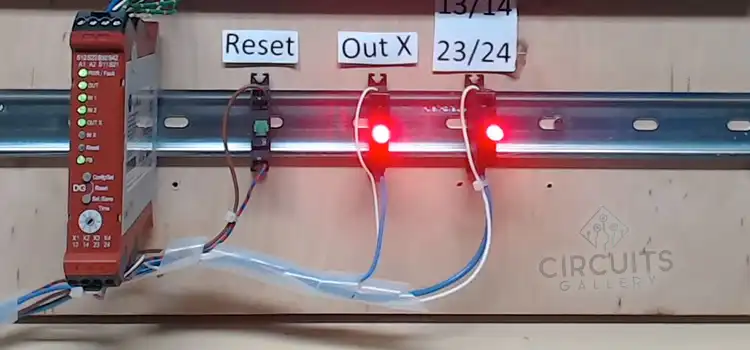
Guardmaster Safety Relay Troubleshooting
In industrial and manufacturing settings, safety is of paramount importance. To safeguard the well-being of employees and protect valuable equipment, companies often rely on safety relays to manage and monitor critical safety functions. Among the popular safety relays in the…
Leave a Reply Cancel reply
Your email address will not be published. Required fields are marked *
Save my name, email, and website in this browser for the next time I comment.
Copy short link
Why Do My Outdoor Lights Keep Tripping? (6 Common Problems)
Yup, we’ve all been there. The circuit breaker keeps tripping and it’s driving you crazy. You might have even Googled it on how to fix the problem. While you might be tempted to call an electrician right away, there are a few simple ways you can troubleshoot it yourself. In this post,
I’ll show you why your outdoor lights keep tripping and how to resolve the issue with the help of 6 common electrical problems.
Table of Contents
What Are the Common Causes of Outdoor Light Tripping?
Outdoor lighting can brighten our pathway home or scare away potential burglars, but at times, it may also lead to light trips. Why do outdoor lights trip? Here are some of the most common reasons:
Reason1: Water Damage
If water gets into your home or garage, then chances are that it will also get inside your light fixtures. This is especially true if they are not properly sealed from moisture. If you notice any signs of mold growth in your lighting system, then you should immediately contact a professional for repair services.
Reason 2: Frayed Wiring
This happens when one wire touches another without being connected together. It could happen due to loose connections, damaged wires, or corrosion. When this occurs, electricity flows through both circuits instead of just one. As a result, the entire fixture shuts off. To prevent short-circuiting, make sure that every connection is tight and secure. Also, check whether the wiring has become frayed over time.
Reason 3: Worn Fittings
Worn fittings cause sparks which eventually lead to shorts. They may look like normal but they aren’t. Check them out carefully before replacing anything.
Reason 4: Bad Grounding Systems
Grounding systems ensure safety by preventing dangerous surges of electricity. But if they fail, then they allow excess currents to pass through. That leads to overheating and eventual damage.
The most common cause is a loose connection in the wiring system or an open circuit somewhere else on your property.
If you’re not sure where it might be, here are some tips for finding out:
- Check all electrical outlets near outdoor lights . If any have tripped recently, check them again.
- Look at the wires that connect the light fixture to its power source. Are there any exposed connections? Is anything dangling from those connections?
- Is the ground wire connected properly?
- Does it touch something solid before going into the earth?
- Does the ground rod extend far enough away from the house so that no one can trip over it when walking around outside?
- Do you see any signs of corrosion on the metal parts of the fixtures themselves? This could indicate a problem with the grounding system.
Reason 5: Faulty Switch Boxes
A faulty switch box causes power surges. These occur because of worn contacts within the fuse box. A surge can damage sensitive electronic equipment such as computers, TVs, stereos, etc. Make sure that the switches work correctly by testing each outlet individually.
Reason 6: Electrical Load More Than The System Can Handle
Overloading means having too many appliances plugged into outlets at once. For example, if you plug two lamps into a single socket, then only one lamp would turn on while the other wouldn’t. The same thing applies to sockets where more than 2 devices can be used simultaneously. You may need to use separate sockets to make your outdoor lighting stop tripping.
What Can I Do to Get Rid of Outdoor Lighting Tripping?
The most common cause for outdoor light trips is when one or more bulbs in your lighting system fail. This could happen if they burn out due to age or because of improper installation. If any bulb fails, that will create a short-circuit which causes the entire fixture to trip off.
It doesn’t matter whether you use incandescent, CFL or LED bulbs; each type has its own unique failure rate. For example, LEDs tend to last longer than other types but still have their share of issues like flickering and dimming over time.
So, before calling an electrician, try these steps first:
1) Check Your Bulbs – First thing you should do is check your bulbs. Make sure none of them are burned out. Also make sure they aren’t loose as well. Loose bulbs pose a fire hazard so don’t leave them unattended.
2) Inspect Fixture – Next, inspect your fixtures. Look at the wiring connections and ensure they haven’t come apart from the socket. If everything looks fine, then move onto step 3.
3) Test Circuit Breaker – After inspecting your sockets, test the circuit breaker by turning it back on. If nothing happens, then turn it off again and wait 10 minutes. Turn it back on once again and see what happens. If the same thing occurs, then something else must be wrong. Call an electrician immediately!
4) Reset Switch – Finally, reset the switch. To do this, simply press down firmly on both sides of the switch until it clicks into place. Once done, flip the switch up and down several times to confirm it works properly.
5) Clean Out Sockets – Now that you know where the problem lies, clean out the sockets thoroughly. Remove dirt and debris that may prevent proper contact between wires and contacts. Use a wire brush or toothbrush to remove anything stuck inside the holes.
6) Reinstall Socket Cover – Lastly, reattach the cover plate to the base of the socket. It helps protect against moisture damage and prevents dust buildup.
Additional Tips
If you want to fix problems with your outdoor lights without hiring an electrician, here are some quick tips to help you get started:
• Replace Incorrect Wires – Before replacing old wires, disconnect the existing ones. Then, look closely at how the new wires connect to the outlet box. The correct way to install wires is shown below:
Once installed correctly, reconnect the wires using the screw terminals located near the bottom of the box. You can also replace damaged wires by cutting away the bad part and splicing in fresh copper wire.
• Repair Damaged Connections – When repairing damaged outlets, start by removing the screws holding the faceplate together. This allows access to all parts of the connection.
Next, carefully examine the electrical components for signs of wear. A worn plug or faulty ground fault interrupter could cause intermittent power loss. In addition, if there’s corrosion around the pins, consider having the outlet replaced.
Alternatively, you can watch the video below for a more detailed instruction:
Related Posts

Solar Outdoor Lights Vs Electric: Which Is Better?

Do Outdoor Lights Need Special Bulbs? (The Truth Revealed)

Do Outdoor Lights Attract Mosquitoes? (Important Facts!)
About author.
Rohan wants to build his own dream backyard to get away from their busy home life. And he also helps bring design to life and build it for his customers using high quality products and building techniques. Rohan has provided many colorful ideas including a water fountain, gazebo, pergola, BBQ area, splash pad, sandbox, and decking with a built-in barbecue.


IMAGES
VIDEO
COMMENTS
Reasons Light Switch Trips Breaker. 1. Light Fixture Fault. If a light fixture is faulty, a breaker can become overloaded. The wires in an old light fixture can fall apart and cause a short or ground out. Turn off power before checking the light fixture for damage. Replace the light fixture if found to be faulty. 2.
The circuit breaker for our kitchen lights trips instantly when I turn on ANY light switch on that circuit. It is 6-month-old new construction and everything worked just fine until a week ago. And then this behavior suddenly started without us changing anything. It is a 15A circuit with five switches:
Devices charging slowly. Electrical outlets not working. Flickering lights. Scorch marks on outlets and light switches. If a circuit breaker keeps tripping in one room, homeowners can test for ...
This miswiring causes the light to turn on even though the switch is off. Because it's improper, it shorts the circuit and trips the breaker when the switch's on. To properly rewire this connection, you will need a marker and proceed to the following steps: First, the circuit breaker's black wire connects to the white wire and other black ...
Find out the cost to replace an electrical panel. On every breaker, there will be an "On" and "Off" position. On a tripped breaker, the handle will be in the middle, neither On nor Off. To reset, flip the handle to Off first, then to On. Stand to the side of the panel and turn your face away when flipping breakers.
Resetting a tripped circuit breaker is a simple process that can be done by following a few easy steps. Here is a step-by-step guide to help you reset a tripped circuit breaker safely and effectively: Step 1: Locating the Tripped Breaker. Step 2: Ensuring Safety Before Proceeding. Step 3: Resetting the Circuit Breaker.
If you suspect a short circuit, unplug your appliances and check the wires for melted coverings. You might also notice a burning smell coming from the outlet. Call in a professional electrician to find the source of the problem. 3. Circuit Overload. Circuit overloads are the most common reason that a breaker trips.
Locate your circuit breaker box and open the cover. Once you've located the tripped breaker, flip it to the "Off" position. Then, flip it back to the "On" position. You should hear a click as the breaker resets. If the breaker trips again, or simply won't reset, there may be a problem with your wiring.
However, circuit breaker trips from flipping a light switch may also be caused by a short circuit due to faulty or damaged wires. Either way, let's take a look at how you can approach the tripped breaker. Turn Appliances and Devices Off. Start by unplugging all appliances, lamps, and other gadgets in the affected area. ...
A circuit breaker is a switch inside your breaker box that monitors the flow of electricity on a circuit and turns off or trips if the circuit becomes damaged or overloaded. ... Turn off all lights and unplug any appliances plugged into an outlet. ... test the circuit by switching on each light. If the breaker doesn't trip again, try plugging ...
A tripping circuit breaker can be an annoying problem. There are, however, three possible causes of your tripping circuit breaker that are easy to DIY.Possib...
Circuit Breaker Tripping: Troubleshooting Guide. A circuit breaker tripping results from short circuits, overloaded circuits, and ground faults. In each case, an unintended excessive flow of current triggers the trip. You must reset the circuit breaker by flipping it back on to restore power.
Flip Back to ON Position. When you find the circuit breaker That's switched off, flip it back into the ON position. You should feel a slight resistance when flipping the lever and hear a clicking sound signaling that it's been flipped back on. This should restore power but if it doesn't, you may need to flip your breaker one more time.
Feb 12, 2015 at 2:04. 1. Try plugging the light into an outlet on another circuit (another room). If it blows the breaker there, the problem is in the light. - DoxyLover. Feb 12, 2015 at 2:43. Did this problem just start happening, or did something change that caused the problem (modified electrical, hung pictures on the wall, got a new light ...
What Causes a Tripped Circuit Breaker . Overloaded circuits: When too many devices are operating on the same circuit and are attempting to pull a higher power load than the circuit can carry, the circuit breaker will trip.; High-power devices: High amp devices like microwaves, dryers, wall heaters, or A/Cs are turned on for sustained periods, they can cause a power breaker trip.
The GFCI trips because it recognizes a drop in voltage that can be potentially dangerous as a safety precaution. If the light switch sends out 120 volts and gets nothing back, the GFCI will trip and shut off. Never take it lightly if your GFCI trips when you turn on the light switch. Call a professional electrician if this happens so that they ...
The breaker can trip even when a switch is turned off. If your electrical circuit is not distributing current properly, reconfigure and reduce the number of loads if needed. Breaker Malfunction. There might be cases where the breaker is faulty, leading to unintentional trips. Replace the breaker with a new one if you find that the breaker is ...
Reason 2: Frayed Wiring. This happens when one wire touches another without being connected together. It could happen due to loose connections, damaged wires, or corrosion. When this occurs, electricity flows through both circuits instead of just one. As a result, the entire fixture shuts off.
Nov 16, 2014 at 14:36. 1. What was done wrong is that you connected something you shouldn't have, or left something exposed which is making contact that it shouldn't. Beyond that, we'd need to know exactly what you did, preferably with photos. - keshlam. Nov 16, 2014 at 15:14. Add a comment. By clicking "Post Your Answer", you agree to ...
1) Always turn the circuit breaker off, and use a voltmeter or test light to make sure you are not dealing with any live circuits.2) This video is intended f...
Now, we have a couple of clues here. This appears to be an AFCI, or maybe DFCI, breaker. The fact that this is tripping when a light switch is flipped on another breaker makes me think the neutrals are connected to each other somewhere. There's a lot of interesting stuff on the circuit that trips, like a server rack with a UPS and some LED lights.